2025-12-20 17:39:33

Americans are upset about the economy. And what are they upset about? Affordability. On polls about America’s most important problem, the cost of living consistently comes in ahead of other issues like inequality, deficits, wages, and unemployment. Here’s the latest from Echelon Insights:

Trump’s approval rating on inflation is lower than for most other issues:
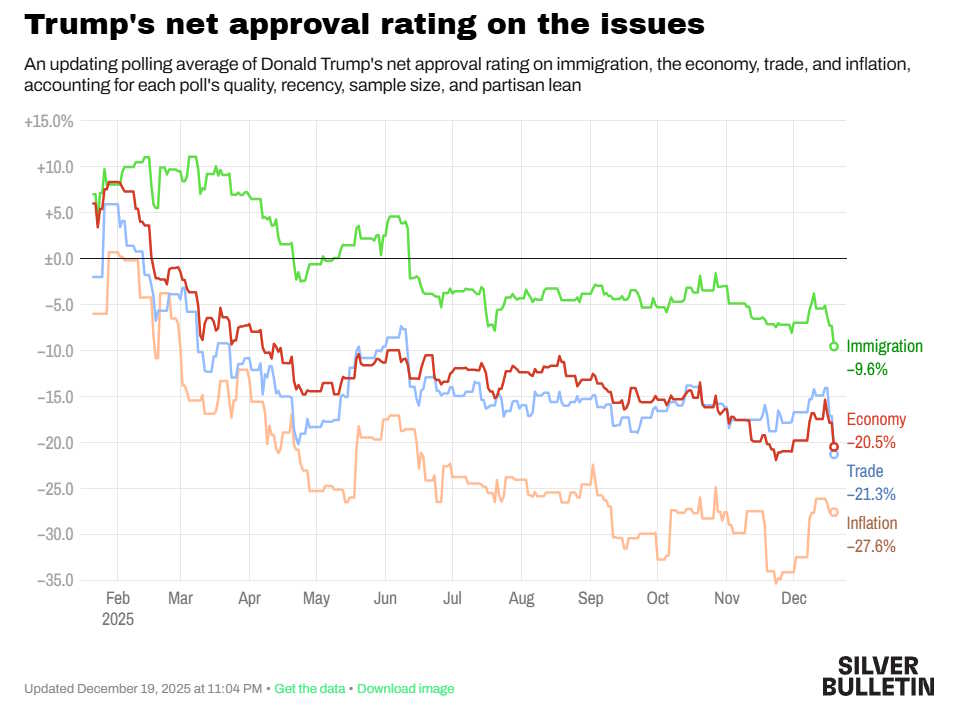
If you’re an economist, this might strike you as a bit odd, because inflation itself is still fairly low, and around 2.7%:
Alternative measures are even lower.
And real wages — i.e., how much an hour of work can buy for the average worker1 — are rising strongly again, after falling in 2021-22:
Of course, lots of regular people don’t trust official statistics. But regardless of whether they rely on government numbers, people’s own inflation expectations are falling, and yet the percent of Americans who blame high prices for their poor personal finances is still near record highs:

Note that for decades, these two numbers tracked each other very well. But in the years since the pandemic, anger at the cost of living has become unmoored from how much people think the cost of living is actually rising.
That’s strange, right?
2025-12-18 15:49:20
In 2004, The Economist predicted that India’s economic growth rate would overtake China’s in two decades. In 2010, in an article called “India’s surprising growth miracle”, they shortened that timeline dramatically, declaring that India might overtake China in terms of GDP growth as early as “2013, if not before”.
In the end, it took two years longer. Since 2015, India has been the world’s fastest-growing major economy, taking the crown from China:
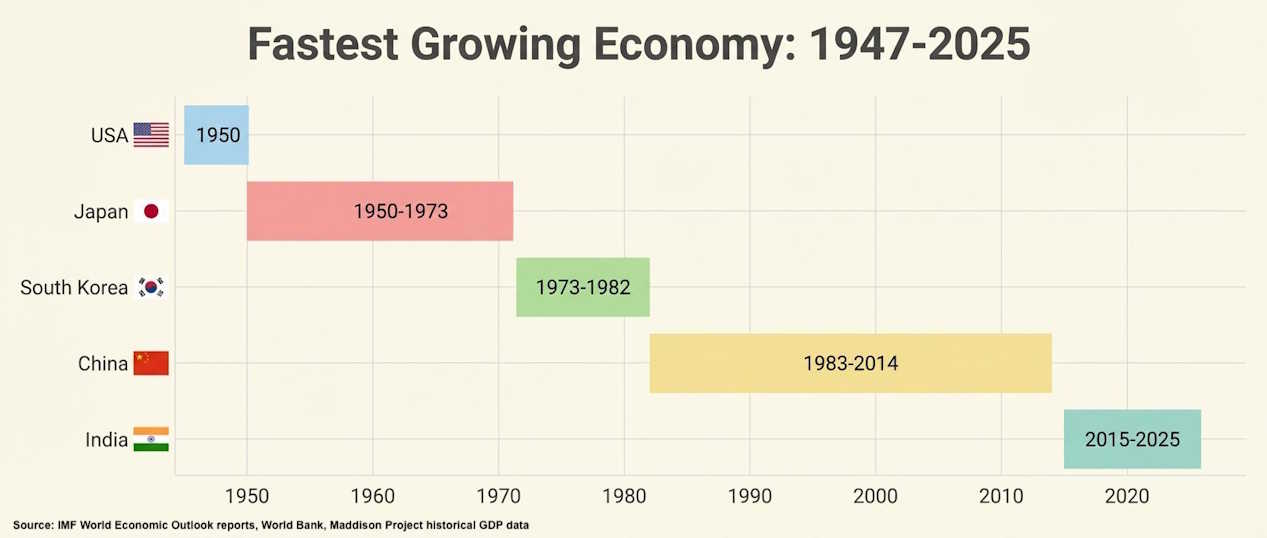
As The Economist noted, this is partly due to India’s more rapid population growth. If we want to look at living standards, we should look at per capita GDP (PPP). Here, India didn’t overtake China until after the pandemic:
India continues to turn in strong growth performances. In the third quarter of this year, it grew at 8.2%, up from 7.8% the previous quarter:
India’s population is growing at a little less than 1% a year, so this roughly corresponds to a per capita growth rate of around 7.2% or 7.3%.
That sort of growth rate is less than South Korea or China managed during their heydays of industrialization. From 1991 to 2013, China’s per capita GDP (PPP) grew at an annualized rate of 9.4%. But 7.2% would still be enough to utterly transform India in just a short space of time.
According to the IMF, India has a per capita GDP (PPP) of $12,101 as of 2025. Thirteen years of growth at 7.2% would bring that to $29,878 — a little higher than where China is today. That’s interesting, because India’s big economic reforms happened in 1991 — twelve years after China’s. Two decades of 7.2% growth would bring India to $48,609 — about as rich as Hungary or Portugal today.
In other words, if India keeps growing as fast as it’s growing right now, it will be a developed country before kids born today are out of college.
Consider even the more modest scenario in which India grows at the same rate it’s been growing over the past decade — about 5.4% in real per capita PPP terms. Fifteen more years of that growth rate would bring India to $26,633 — about where China and Thailand are today. Twenty years, and it would be $34,644 — about the same as Chile.
This is all a big “if”, of course. When I threw out some optimistic growth scenarios on X, I was mercilessly mocked:
But this critique is overdone. Yes, it’s likely that India, like China, and like every other rapidly industrializing country, will experience a slowdown in growth as it gets richer. But growth could also accelerate for a while. China’s growth slowed in the 1990s, but then accelerated in the 2000s after it joined the WTO:
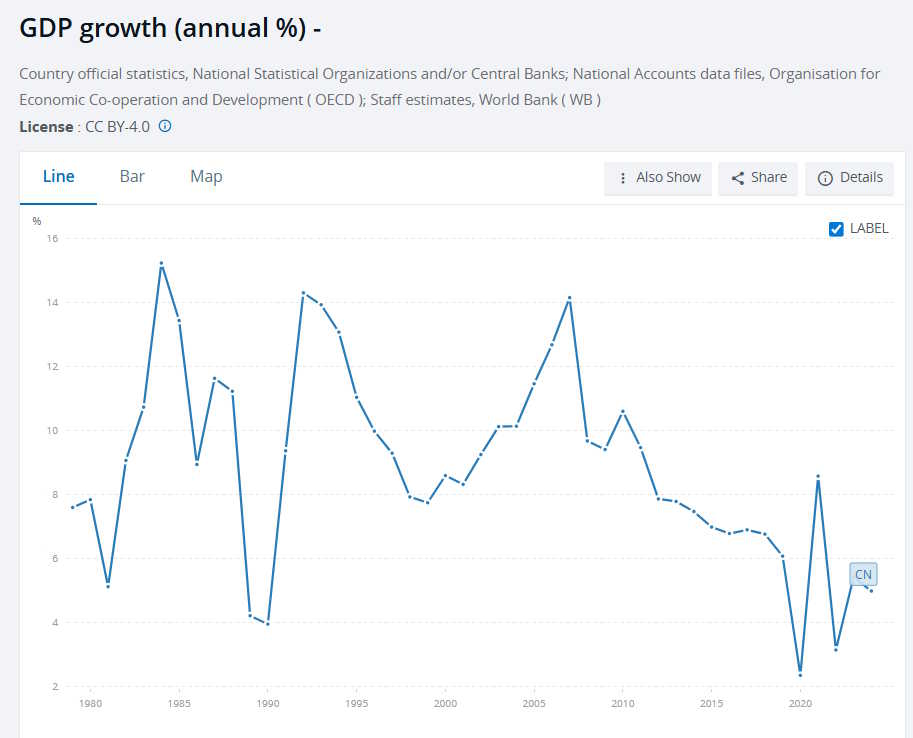
Growth is not always a smooth deceleration; sometimes it goes up for a while. And if Indian policy improves, it could see growth accelerate — or at least remain high as the country gets richer.
And India is still experimenting with policy reforms. Just the other day, it rolled out a major reform of its sclerotic labor laws:
India implemented overhauled labor laws that aim to attract investments and make it easier for companies to do business in the South Asian nation…The laws, grouped in four separate codes, replace archaic legislation and will give flexibility to companies to hire and fire workers, enhance safety standards and extend guaranteed social security benefits…
India’s maze of labor regulations, both at federal and state level, are considered to be rigid and complex, forcing companies to either remain small, employ fewer workers or use capital-intensive methods of production. The latest attempt is expected to make the rules uniform across the country[.]
Among other things, the new law allows women to work night shifts. This has the potential to help address India’s glaringly low female labor force participation rate. Most manufacturing miracles in history started with women migrating from farms to cities to work in labor-intensive light industry (garments, toys, electronics, etc.).1 If India manages to unlock this classic labor resource, it could not only give India a stronger manufacturing base, but also improve the country’s oddly low rate of urbanization.
I don’t mean to claim that this labor law reform will propel India to two decades of 7% growth. By itself, it won’t. But it shows that India’s government is able to push through pro-growth reforms over the objections of incumbent stakeholders. And it shows that the government cares enough about growth to do this.
There’s a theory out there, espoused by A.O. Hirschman back in the 1950s, that economic development creates political support for further development. Once the people of a country realize that rapid economic growth is possible, they may get used to the idea of their living standards increasing noticeably every year. On top of that, many elites become invested in the institutions of growth — owning construction companies, banks, and so on — and thus it’s in their interest for growth to continue.
Basically, this is the idea that Indians are not going to look back at two decades of fairly rapid growth — growth that has brought the country out of desperate poverty into lower-middle-income status — and conclude that this was enough. Instead, they may be willing to do the hard work of overruling vested interests — like the labor groups who resisted the recent labor law changes — in favor of reforms that promise to keep the economic party going.
Which other reforms would be key? For one thing, India needs to reform its financial system in order to help its companies scale up. The country currently has a very high cost of capital, meaning it’s hard for companies to borrow and grow. Fixing bond markets is one idea here, but most countries that experience economic growth “miracles” rely heavily on bank finance instead of on bond markets.
Beyond finance and harnessing rural women’s labor, there’s also probably a lot more India can do to boost their manufacturing sector. In a Noahpinion guest post this summer, Prakash Loungani and Karan Bhasin wrote down some ideas for how to do this:
In a nutshell, their suggestions are:
Repeal regulations that specifically stop large manufacturing companies from firing employees
Repeal local laws that make it hard to convert agricultural land to industrial use
Conduct more trade agreements, e.g. with Europe
Reduce red tape for manufacturers
This brings me to another reason I’m bullish on India is that there’s still a huge amount of room for manufacturing to grow. Right now, despite being the world’s fifth-largest manufacturer, India is still a service-intensive economy — manufacturing is only 13% of the country’s GDP. This has led some people to conclude that India just isn’t a country that can make things, and that they should stick to services. But recently there have been some hopeful signs for Indian industry.
For one thing, manufacturing has already been key to India’s rapid growth over the past few years. Menaka Doshi points out that “corporate investment announcements between April [and] September are at a decade high of 15.1 trillion rupees, led by manufacturing firms.” And India’s exports, especially of electronics, are rising:
India clocked the highest goods exports for November in 10 years. Two factors seem to have helped the country counter Trump’s 50% tariff. Buoyant electronics exports, of which Apple iPhones are expected to be the largest chunk. And export diversification, including to China…November trade data…shows India’s exports rose to $38.13 billion — up 19.4% from a year earlier, the biggest jump since June 2022…
Earlier this year, Apple expanded iPhone production in India to fulfill the majority of US demand.
Apple, the world’s best electronics company, is steadily moving more iPhone production to India. That shift, which has been happening since the pandemic, has been helping to drive an Indian electronics export boom:
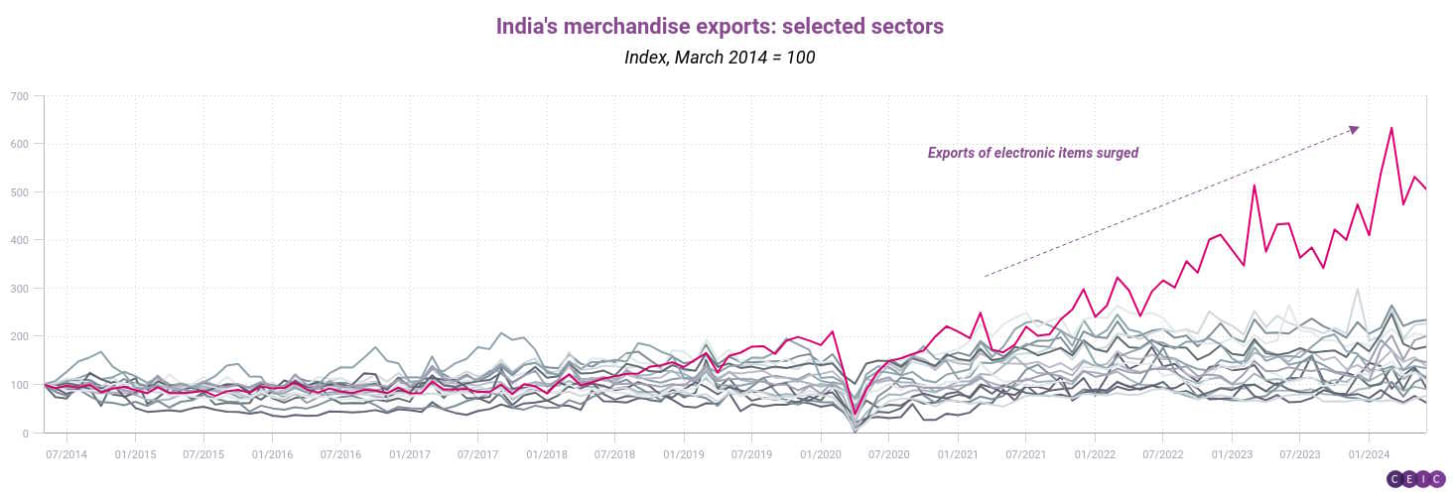
The boom is still in its infancy, but this just gives it more room to grow. Right now, India’s electronics exports are mostly phones, but this just gives India the opportunity to expand into assembling computers and other electronics.
And while electronics assembly is the lowest part of the value chain, India may be climbing that ladder already. There are also reports that Apple is considering making some of the components of the iPhone in India as well:
Apple is in preliminary talks with some Indian chip manufacturers to assemble and package the component for the iPhone, said people with knowledge of the matter, a move that would mark a key step up in the value chain for vendors to the tech giant…It’s the first time Apple is evaluating the prospect of having certain chips assembled and packaged in India[.]
Components — mostly semiconductors of various sorts — represent the bulk of the value in an iPhone or other piece of modern electronics. Packaging and testing chips is a much higher-value activity than simply slapping components together into a final product.
In fact, India has recently focused on promoting the chip packaging and testing industry, often by soliciting foreign direct investment in the sector. This was how Malaysia became an electronics powerhouse, helping to propel that country to a GDP (PPP) of almost $44,000. It’s a very good strategy for India.
In any case, India just looks like a very promising growth story to me. The country has already been growing at a decently rapid clip, and its income levels are still low enough that it has lots of room to catch up with the technological frontier. It has shown that it still has the political will to push through major reforms, and its manufacturing sector is improving and has plenty of space to grow. It has a huge domestic market that will help its companies achieve scale. It has plenty of elite engineers and such. And due to its democracy and general friendliness, it’s looking like a more attractive production base than China for many multinational companies like Apple.
So what’s the bear case here? What are the key arguments that India can’t grow to become a comfortably upper-middle-income country over the next two decades?
One common idea, expressed by former Singaporean Prime Minister Lee Kuan Yew, is that India will always be held back by internal fragmentation. Lee called India “not a real country”, “32 separate nations”, and “many nations along a British railway line”.
Linguistic fragmentation is certainly a challenge for India. But the country’s regions show no inclination to break away. And federalism can be a strength, too. There was an interesting story in The Economist recently comparing the economic growth models of Indian states Gujarat and Tamil Nadu. Gujarat has focused on building infrastructure, and has pursued capital-intensive industries like chemical manufacturing; Tamil Nadu has focused on improving education and health, and has pursued labor-intensive industries like electronics assembly.
But while The Economist pits these models against each other, the truth is that it’s probably good for a country to have both. A complex, diversified economy tends to grow faster than one that focuses on a single narrow range of industries. If India’s states find different paths to success, that could make the Indian economy more resilient in some ways than China, which is currently discovering the downsides of having a strong government that tells every province to make the same things.
Another bear case for India is the idea that China will throttle India’s rise. The reigning industrial powers of the 20th century — the U.S., Europe, Japan, and Korea — were remarkably nice to China during its early industrialization, cheerfully opening their markets to Chinese products and setting up joint ventures to teach Chinese people how to make anything and everything.
But China, the current reigning industrial power, is unlikely to be so nice to India. As expert China-watcher Rush Doshi explains, China’s current leadership wants to monopolize global manufacturing now and for all time. That explains why as Indian electronics manufacturing has ramped up, China has tried to block its engineers from going to India to train their replacements. I wrote a post about this back in March:
But I don’t believe this will cripple India’s growth model. China isn’t the only country that makes things; there are plenty of engineers from South Korea, Japan, Taiwan, the U.S., and Europe who can get Indians started making things. And as Xi Jinping’s regime continues to be repressive, and China’s growth continues to slow, lots of Chinese engineers will find ways to move to a country with more rapid growth and more personal freedom.
My guess is that the most important reason for widespread skepticism about India’s growth prospects is something that most people are too polite to say, except behind the shield of anonymity on a platform like X. A lot of people just don’t believe that Indians, as a people, have what it takes to build a modern high-tech economy. When I express optimism about India’s growth, someone always chimes in to say that Indians have low national IQ:
Let us set aside for a moment the question of whether national IQ studies are reliable. As the more circumspect of the two tweets above notes, cognitive ability and economic success are a two-way street. Though cognitive ability probably does boost growth, the reverse is also true — as countries get richer, they get better nutrition, more schooling, reduced pollution, and air conditioning, all of which contribute to better cognitive performance.
I view these discussions of IQ as a stand-in for something deeper — a suspicion that countries made up of people who aren’t of European or East Asian descent simply aren’t capable of building a wealthy, high-tech society. Although people of Indian descent have succeeded spectacularly in countries from the U.S. to Singapore to the UAE, no country in South Asia has reached upper-middle-income status — India, Pakistan, Sri Lanka, Bangladesh, Nepal, and Bhutan are all still pretty poor. So because none of these countries has done it, a lot of people just assume that none of them can do it.
If you think about it, that assumption doesn’t make a lot of sense. Some country always has to be the first in its region to industrialize. Before Japan beat Russia in a war in 1905, Europeans didn’t think East Asian countries could become modern industrialized powers. And it wasn’t until the success of Japan’s auto and machinery industries in the 1970s that the world came to respect East Asian industrial prowess.
Nowadays, no one thinks it’s odd or unusual if an East Asian country gets rich; in fact, people suspect it. But there had to be a first country in the region to break old stereotypes and assumptions, and that country was Japan.
India is a much bigger country than Japan, which presents a challenge. It seems intuitively harder for a giant country like India to be the first in its region to break the old stereotypes and wow the world. But if you believe economists’ estimates, India is now about as rich a country as Japan was in 1962. The task is not insurmountable.
Call me crazy, but I think India can do it.
Updates
Commenter Jack Lowenstein writes:
As a long time India bull and former professional investor in listed equities there, I would add three points:
1) a positive byproduct of the high cost of capital is that ROEs are also high, and also that because debt capital is scarce, banks remain filters, not funnels. Nor does the Indian government coerce capital into SOEs.
2) fraud and corruption are often posited as negatives for the investment and growth story. However all though these are easy to find, I suggest India’s greater transparency compared to China, as made them less universal.
3) while many countries have great technical universities, I wonder if any have the level of competitive entry as the Indian Institutes of Technology. The nearest equivalent I can think of is French engineering schools.
(1) is an important point; at this early level of development, India needs to worry less about allocating resources and more about mobilizing resources.
(2) is interesting, because there’s some work claiming that China’s type of corruption — like America’s in the late 1800s — gave government officials an unofficial equity stake in development, and therefore encouraged development. It was “corruption”, but the kind of corruption that led to aligned incentives.
Meanwhile, India just passed another big reform package — this one about finance:
[L]awmakers passed a bill this week allowing up to 100% foreign ownership of insurance firms, bolstering an industry long viewed as under-penetrated and capital-starved. Regulators have also overhauled rules for banks, pension funds and capital markets as they aim to shift savings from idle assets such as gold and property toward equities, bonds and long-term investments to finance factories and infrastructure.
All these reforms come as Prime Minister Narendra Modi and his administration want to make India a developed economy by 2047, a goal that requires economic growth of about 8% per year[.]
I’m especially excited about the banking reform, whose goal is creating larger banks while also increasing the number of banks in the country. Of all the reforms in the package, this one seems the most likely to have a major impact.
Note the importance of growth targets in pushing through this reform. If India hadn’t grown at 8% in some recent years, it seems unlikely the government would feel confident in setting 8% as a growth target. This suggests that growth is creating expectations for further growth, which is creating momentum for policy reform.
My favorite book about this is Leslie Chang’s Factory Girls, which follows several of these women in China and chronicles the country’s growth through their eyes.
2025-12-17 18:04:22

My book, Weeb Economy came out in March, but only in Japanese. Half of the book was a series of translated posts from my blog, so those are already in English. The other half was a new part that I wrote in English and had translated into Japanese by my excellent translator, Kataoka Hirohito. So while I’ll eventually republish the whole book in English, what I can do right now is to publish my English-language first draft as a series of posts on this blog.
The first installment was entitled “I Want the Japanese Future Back!”. In that post, I explained why Japan now finds itself in the position of a developing country, playing catch-up with other countries. This means Japan needs to experiment with bold new strategies and development models, as it did in ages past.
In this second installment, I suggest one such experiment: a huge increase in a kind of investment called greenfield FDI. I discuss:
How Japan is already benefitting from greenfield FDI in a few places
Why greenfield FDI (a foreign company building a factory or research center in Japan) is so much more important and useful than other kinds of FDI like mergers and acquisitions
Why Japan needs to export a lot more to other countries, and how greenfield FDI can help do that
How Japan can start to welcome more greenfield FDI
Why Japan is an attractive destination for international investment
The semiconductor industry is probably the most important industry in the world. Computer chips are absolutely essential to every high-value product in a modern economy — autos, rockets, appliances, machinery, everything. They’re also of crucial military importance, in an age where precision weaponry rules the battlefield. And they’re of core importance to emerging technologies like AI — whose vast computational resources require enormous data centers — and biotech.
As a result, it’s no wonder that the world’s major economies have been fighting over the semiconductor industry for generations. In the early days, the U.S. and Japan were the clear leaders. Much of the industry involves the design of semiconductors and the production of specialized tools and materials, and in these upstream parts of the industry the U.S. and Japan are still strong. But in the most important downstream part of the process — the actual fabrication of the most advanced chips — both the U.S. and Japan have lost their lead to Taiwan:
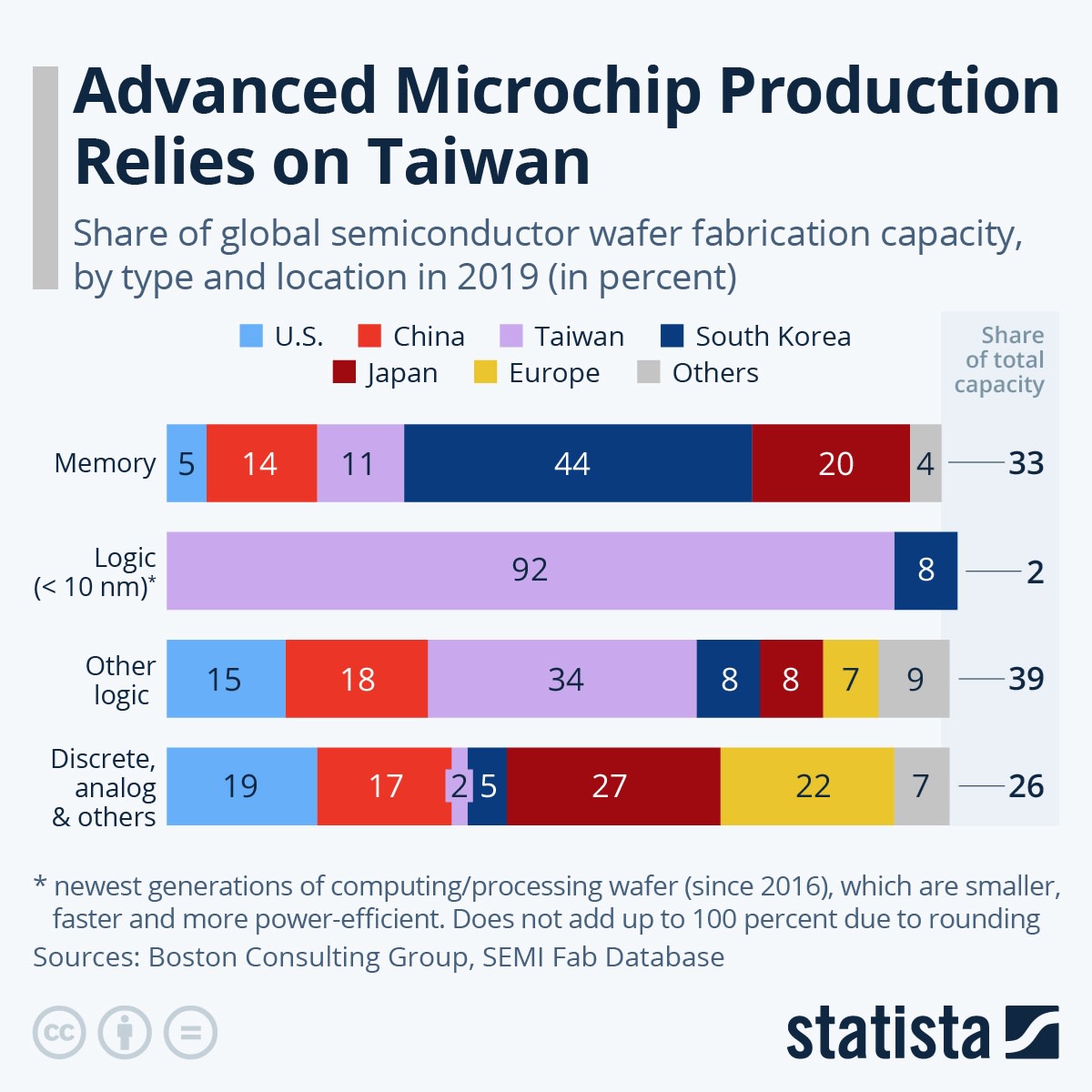
Specifically, they have lost their lead to one remarkable Taiwanese company: Taiwan Semiconductor Manufacturing Company. TSMC are essentially the world’s greatest machinists. Other companies design the chips, and other companies create the (incredibly advanced) machine tools that make the chips. What TSMC does is to buy the tools, and then use the tools with incredible ingenuity and efficiency to make someone else’s chips designs into reality. They pioneered this “pure-play foundry” business model, and it has made them rich — and it has allowed Taiwan to outcompete the chipmaking industries of every other country on the planet.
Since the pandemic, the global battle to win semiconductor market share has intensified, due to the advent of AI and to the geopolitical competition between China and the democratic countries. Japan, like many countries, is trying to build its own foundry business, in the form of Rapidus, a joint venture between a bunch of Japanese companies that’s also getting some help from IBM. But — also like in the U.S. there’s also a second, parallel effort afoot. Japan is building chips for TSMC.
In late 2021, TSMC created a Japanese subsidiary called Japan Advanced Semiconductor Manufacturing (JASM), and started building two fabs in Kumamoto prefecture. Sony and Denso pitched in to help. So did the Japanese government, providing billions of dollars in subsidies and offering TSMC logistical assistance in finding local workers and ensuring adequate water and other infrastructure. The first plant was completed very quickly, and opened in February 2024; the second is expected to open in 2025. Now TSMC is considering a third fab in Kumamoto, producing even more advanced chips, to be opened in 2030.
Observers have been impressed with the speed with which the fab was built, comparing it favorably to TSMC’s plant in America, which initially suffered delays. TSMC credited the successful construction to a variety of local supporting institutions — “suppliers, customers, business partners, government and academia.” TSMC’s founder Morris Chang, who once poked fun at Japan for the slow speed of its business dealings, has now become a true believer in the revival of the country’s chip industry. At the opening of the first TSMC plant in Kumamoto, Chang predicted a “renaissance of semiconductors” in Japan.
And Japan isn’t stopping with TSMC. Micron, an American chip company, is building a fab in Hiroshima, bringing some of its best technology into the country. Samsung is building a semiconductor development center in Yokohama. Both of these investments are being done with significant help from the Japanese government, and involve cooperation with Japanese companies and universities.
These investments by foreign companies aren’t Japan’s only strategy for reviving its semiconductor industry — they coexist alongside homegrown efforts like Rapidus, as well as Japan’s upstream efforts in the chipmaking tool and materials industries. But they represent a crucial addition to the purely indigenous efforts. This is an example of multi-strategy development at work.
But it’s far from the only such example.
The artificial intelligence boom is the most important trend in the software industry right now. Whether this remains true in future years remains to be seen, of course, but the capabilities of large language models like ChatGPT, AI art software like Midjourney, and computer vision systems are undeniable. Even if there’s a bubble and bust in the field at some point — as there was with dot-com companies in 2000 — AI is going to be important in the long term.
Japan largely missed out on the internet software boom — the country has no internationally dominant consumer internet giants like Google or Facebook, and its B2B software industry was hampered by Japanese companies’ slowness to adopt IT solutions in past decades. But the AI age is a new dawn, and Japan has another shot at building a powerful software industry.
At the time of this writing, one of the most interesting AI startups in Japan is Sakana AI. Currently, AI applications generally use one large statistical model to generate text, create images, recognize objects, predict the shape of a protein, etc. Sakana tries to instead use groups of smaller models to accomplish the same thing. In addition to being able to do some things better than big models, these groups of smaller models may use much less electric power — an important consideration, when AI’s energy needs are skyrocketing.
Sakana AI has three founders. There’s Llion Jones, originally from Wales, who was one of the authors of the groundbreaking 2017 research paper that discovered the algorithm now used to make LLMs. There’s David Ha, originally from Canada, who was an AI researcher at Google Brain. And there’s Ito Ren, a Japanese former diplomat who was an executive at the e-commerce company Mercari.
The company’s investors are equally international — it includes American venture capital firms like Khosla Ventures, Lux Capital, and New Enterprise Associates, the American semiconductor giant Nvidia, and a large assortment of Japanese banks and technology companies. Sakana’s most recent funding round raised $214 million, and valued the company at $1.5 billion.
That’s not a huge valuation compared to U.S. giants like OpenAI ($150 billion) or Anthropic (possible valuation of $40 billion). But Sakana’s presence has put Japan on the map as a potential hotspot for international AI investment. Nvidia, for example, has declared its intention to create an R&D center in Japan. OpenAI has opened a branch office in Tokyo. Oracle is investing $8 billion over the next decade in AI and cloud computing in Japan. This is in addition, of course, to all the big cloud providers — Amazon, Microsoft, and Google — looking to invest in Japan in order to serve the Japanese market.
Then there’s Spellbrush, a U.S. startup that has a partnership with the AI art and design company Midjourney. Spellbrush uses generative AI to create Japanese-style anime art — one of the most popular and lucrative applications for AI so far. Spellbrush recently opened a branch office in Tokyo’s Akihabara neighborhood.
Japan is still behind the U.S. and China in AI, but investments like these keep it in the game.
It’s important to note that although Sakana AI might succeed, the most likely outcome is that the company will fail. This is true because most startups fail in general, and because in a rapidly changing new industry like AI, the failure rate is likely to be even higher. In fact, the entire AI industry may be headed for a significant bust, like the dotcom crash in 2000.
But this shouldn’t negate the importance of Sakana, or of the Japanese AI boom in general. First of all, though most startups fail, the few that succeed often grow very large and important — venture investing is about accepting many failures in order to find a few huge wins. The investment and attention that Sakana draws to the Japanese AI startup scene will help make sure that some of those successes happen in Japan. Even a general AI bust will likely only be a temporary setback to the industry, as with the dotcom crash and the subsequent recovery.
Second, even failed startups often contribute crucial innovation to a country’s ecosystem. Fairchild Semiconductor wasn’t successful, but it pushed the envelope of semiconductor technology forward, and some of its alumni went on to found Intel. General Magic tried and failed to invent the smartphone in the 1990s, but its alumni went on to help create the iPhone.
And third, Sakana sends a signal that Japan is a viable destination for international investment in the software industry in general, well beyond AI. Japan is generally weak in most areas of IT, including B2B solutions, consumer internet companies, and cloud computing providers. As in semiconductors, a wave of foreign entrepreneurs and foreign funding could help Japan shore up its weak spot in software.
The chipmaking projects by TSMC, Micron, and Samsung, the U.S. VCs’ investment in Sakana AI, and the branch offices of companies like OpenAI are all examples of foreign direct investment, or FDI. But they’re not the only type, and when people talk about FDI, they often mean something very different. In fact, it’s actually a bit of a confusing term, because it encompasses multiple unrelated categories of investment. FDI includes:
Cross-border real estate purchases
Acquiring a foreign company (M&A)
Building a branch office or factory in a foreign country (“greenfield” investment)
Most writers who advocate for Japan to increase FDI focus on the second of these. They believe that allowing more foreign acquisition of Japanese companies will improve these companies’ productivity by transferring foreign management techniques.
I am agnostic concerning this argument. I recognize that Japan’s policymakers and businesses have many reasons for resisting foreign acquisitions, both as part of the country’s development strategy and part of its social policy. Foreign buyers might downsize Japanese companies by firing large numbers of employees, which would hurt Japan’s corporation-centric social welfare model. They might strip-mine Japanese companies for their technology or other assets and then sell them off as husks of their former selves, as happens all too often with leveraged buyouts in the United States. Or they might simply neglect their Japanese acquisitions until they stagnated.
Instead, my argument is that Japan should focus specifically on increasing and promoting greenfield FDI — foreign companies building their own branch offices and factories in Japan. And in particular, Japan should encourage greenfield platform FDI, in which a foreign company builds factories or offices in Japan in order to create goods and services that are then exported from Japan to a third country. TSMC’s chip fabs in Kumamoto are an example of greenfield platform FDI.
This particular kind of FDI offers a lot of benefits that foreign takeovers don’t. For one thing, greenfield FDI usually directly adds to the economy — when a foreign company builds a factory in Japan, or even just purchases office equipment for a new office, that represents real money that goes directly into Japanese people’s pockets. And greenfield FDI inevitably results in the hiring of more Japanese workers, since someone has to work at the new factory or office branch.
Investment spending and workers’ salaries in turn stimulate the surrounding local economy — already, Kumamoto is experiencing an economic boom. Note that M&A doesn’t necessarily accomplish any of this — it just changes ownership of existing businesses, without requiring any new investment, hiring, or spending on the local economy.
And greenfield FDI is also more likely to be received warmly by the Japanese public. Ito, Tanaka, and Jinji (2023) find that Japanese people feel more positively about greenfield FDI than about foreign acquisitions:
This study empirically examines the determinants of individuals’ attitudes about inward foreign direct investment (FDI) using responses from questionnaire surveys that were originally designed. Individuals’ preferences for inward FDI differ between greenfield investments and mergers and acquisitions (M&A), and people are more likely to have a negative attitude toward M&A than greenfield investments. People with a negative image of the so-called “vulture fund” for foreign capital tend to oppose inward FDI, and this is more pronounced for M&A than greenfield investments.
On top of all this, greenfield platform FDI has a very good economic track record. It has been key to the economic success of a number of developing countries — most notably China, but also Poland and Malaysia.
After China’s entry into the World Trade Organization in 2001, companies from around the world flocked there to set up factories — both to sell their products to a billion newly available Chinese consumers, but also to exploit what at the time were cheap Chinese labor, land, energy, and capital costs, in order to make products for export to the rest of the world. This is known as “platform FDI”.
Poland executed a similar strategy on a smaller scale, becoming a factory floor for European nations — especially Germany — looking for lower costs and more friendly regulation. Malaysia became a center of electronics manufacturing, with investments from the U.S., Singapore, Japan, and elsewhere. In both of these cases, the products of foreign-owned factories were largely sold abroad, since both Poland and Malaysia have relatively small domestic markets. FDI thus helped to make China, Poland, and Malaysia into export powerhouses.
Japan, of course, is in a very different economic situation than China, Poland, or Malaysia were in the 2000s. But it can still learn from their successes. In addition to the direct benefits for investment and employment, greenfield platform FDI offers two main advantages: it can increase a country’s exports, while also facilitating technology transfer. In its current economic situation, Japan could use a whole lot of both of these things.
Americans often think of Japan as an export powerhouse, because of the international success of brands like Toyota, Honda, Sony, and Panasonic. And during the early days of the postwar miracle, Japan’s bureaucracy did strongly encourage exports, in order to earn precious foreign currency. But in fact, this lingering stereotype is badly mistaken — Japan has never really been an export-oriented economy like Germany or South Korea. It’s a domestically focused economy, more like the United States:
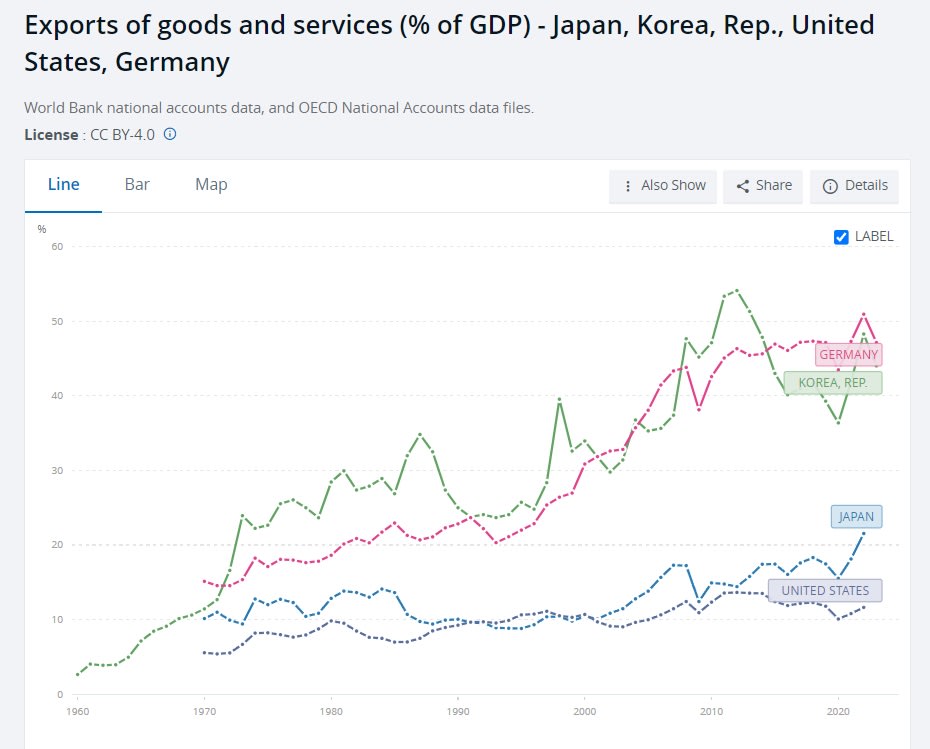
As Chalmers Johnson recounts in MITI and the Japanese Miracle, this inward focus was part of Japan’s development model in the 1960s. MITI found that ensuring cheap bank loans to domestic companies, and promoting competition in the domestic market, was a way to quickly boost Japan’s investment rate and its capital stock. And they found that this approach also ensured an adequate level of exports, since Japanese companies would produce more than they could sell in the domestic market, and export the excess capacity overseas.
Now, Japan finds itself badly in need of exports. The first reason is that exports help increase the value of the yen, making Japanese people richer as a result.
Japan’s currency has weakened dramatically against the dollar and other world currencies. This is partly because of Japan’s low interest rates relative to other rich countries, which is driven by Japan’s low inflation (and probably by a need to keep Japanese government borrowing costs low, in order to make Japan’s very large government debt sustainable).
As a result of the weak yen, Japanese people are finding it increasingly difficult to afford imports. Japan imports most of its food and energy, so the weak yen is increasing the cost of daily life. Japanese companies are having trouble importing the parts and materials they need, as well as energy. The Japanese government has been forced to intervene to prop up the value of the yen. But such interventions can’t last forever, since they require selling off foreign assets — eventually, the government runs out of foreign assets to sell, and the currency crashes even more.
An increase in global demand for Japanese exports can help increase the value of the yen. This is because in order to buy Japanese goods and services, foreigners need to swap their currencies for yen. This increases the demand for the yen, which pushes up its value. The more exports Japan sells, the stronger the yen becomes. Ultimately, Japan’s currency problem probably can’t be fixed by exports alone — financial outflows will have to be addressed as well. But exports help.
The second reason for Japan to focus on exports is that the domestic Japanese market is shrinking. Japan’s population is forecast to fall substantially over the remainder of this century:
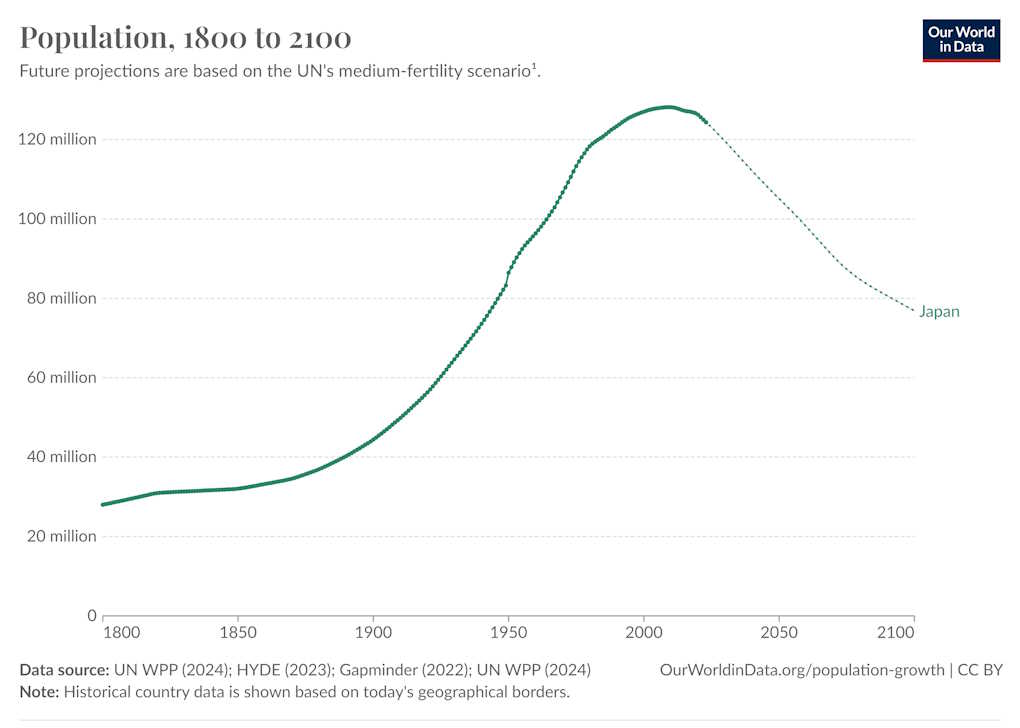
Mass immigration may slow this trend, and measures to increase the birth rate may eventually manage to reverse it. But whether that will ever happen is unknown, and even if it does, Japan will not be a major growth market for a long while. This means there is much less incentive for companies — Japanese or foreign — to invest in Japan in order to serve the domestic market than in the past. Less investment also means less spending on R&D, which causes Japan to fall behind technologically.
Exporting can help reduce this problem, or even solve it. The more Japan becomes an attractive platform for export production, the more reason there is for Japanese companies and foreign companies to invest in Japan, including investments in R&D and new technologies. This will help increase productivity.
Finally, the activities required to increase exports may improve productivity. There’s a lot of research on “learning by exporting” — entering foreign markets could teach Japanese engineers, product designers, and managers how to produce things that foreigners want to buy. This could help counter the so-called “Galapagos syndrome” — the tendency of Japanese product standards to drift away from international standards, shrinking the markets available to Japanese companies.
Another way to put this is that exporting allows companies based in Japan — whether domestically owned or foreign-owned — to achieve scale without exacerbating competition that drives down prices.
Greenfield platform FDI — like TSMC’s fabs in Kumamoto or American venture capitalists’ investment in AI startups in Tokyo — can help Japan become more of an export powerhouse. Okubo, Wagner, and Yamada (2017) find that foreign-owned factories in Japan tend to export more — and also to innovate more. Their explanations for the difference have to do with corporate governance and culture, and with the pool of employees that foreign-owned companies are able to hire. They write:
Foreign ownership may play a role in risk-taking choices of companies – such as exporting and innovating – for various reasons. It can provide companies with more information about the outside market, especially in the context of small and medium enterprises. Foreign owners may be keen on getting high returns on investment and may tolerate a higher risk level. Firms with foreign ownership may have greater access to funds. Also, firms that do allow foreign ownership may experience a more open corporate culture than firms that do not, and such open culture may facilitate risk-taking.
The simplest explanation here is that multinational companies — especially those with foreign employees — simply know a lot more about global markets. TSMC knows what kind of computer chips Nvidia and Apple want to buy. Sakana AI’s founders keep in touch with the American AI market, and understand what kind of capabilities U.S. companies want from AI models. And so on.
In other words, greenfield platform FDI is a perfect example of multi-strategy development. It means that instead of coming into Japan to compete with local companies in the Japanese market, foreign companies are helping Japan sell a bunch of new products to a bunch of new overseas customers.
Japan’s low levels of productivity are somewhat of a mystery to researchers. Nakamura, Kaihatsu, and Yagi (2018), a trio of researchers from the Bank of Japan, arrive at the frustrating conclusion that the biggest problem is a lack of “intangible assets” at Japanese companies. These are any non-physical assets — brand reputation, patents, software, long-term customer relationships, management know-how, worker skills, tacit technical know-how, and so on.
This is such an enormously broad and heterogeneous category, and so many of its components are hard to measure, that “intangible assets” basically ends up becoming a label for economists’ ignorance about what makes some companies more valuable than others. For example, Nakamura et al. note that Japanese companies spend quite a lot on R&D, but don’t seem to get nearly as much value for their spending as U.S. companies do.
So the mystery remains a mystery. But even if we don’t quite know what the most important intangible assets are, we still might be able to help companies get more of them. Nakamura et al. suggest a fairly standard, reasonable list of approaches — increasing labor mobility, improving corporate governance, allowing more lagging companies to fail, and improving the venture capital ecosystem. These are all reasonable approaches, and — as we saw above — they’re all things that Japan is already trying to some greater or lesser degree.
But there’s one strategy that seems to be flying a bit under the radar here: FDI. When foreign companies put their factories, offices, and research centers in Japan, they bring many intangible assets with them — foreign management techniques, technical tricks and know-how, connections to customers and suppliers in other countries, and so on. And these can, for the most part, be pretty easily transferred to Japanese companies.
One way, which has been thoroughly documented by researchers, is through interactions with local suppliers. When a company like TSMC puts a semiconductor fab in Japan, one reason is so that it can buy a bunch of specialized tools and components from Japanese suppliers — like the photoresist that Japanese companies are so famous for. This in turn teaches Japanese suppliers what the leading chip companies need and how to best serve them, as well as details about how the best chipmaking tools work. Those kinds of knowledge are both intangible assets.
Another way ideas spread is through job-switching. TSMC’s fab is going to employ a bunch of Japanese workers. Those workers are going to get the chance to learn how to make chips from the very best in the business. If some of them eventually leave to go work at Japanese semiconductor companies, they’ll take all that knowledge with them. This sort of knowledge transfer would have been harder in the old days, when Japan was still under the lifetime employment system. But now, with mid-career hiring on the rise, it’s very likely.
Let’s imagine an example of how this might work. Suppose you’re a Japanese AI researcher at a domestic AI startup. You and your team know a lot about AI models, from reading research papers, from building them yourself, and maybe from going to some conferences overseas. But for some reason your models aren’t quite as good as foreign companies’ models. The foreigners must have a bunch of little tricks they use to make things work better.
Then one day your company hires another researcher who worked at Sakana AI. Your new colleague knows a lot of those tips and tricks for making models work more smoothly, from having worked with some of the top researchers at Sakana. And their time at Sakana also gave them personal connections with a bunch of other researchers overseas, whom you can now call up and ask for help solving your model’s problems.
Congratulations! You’ve just transferred tacit knowledge for free. Your company’s intangible assets have increased.
If this example sounds contrived, consider how many of Japan’s most famous inventions came through interaction with foreigners and absorption of foreign knowledge. Japan’s Canon cooperated with America’s Hewlett Packard in the 1980s to create laser printers. Yamaha created the digital synthesizer with the help of a Stanford engineer named John Chowning. The famous inventor Sasaki Tadashi licensed American patents to help him invent the first commercially viable pocket calculator.
Those are all examples from the book We Were Burning. In other words, in the 20th century, close links between Japan and the U.S. created a vibrant international research community, where ideas flowed back and forth across borders and across companies.
In fact, there’s evidence that this is a consistent pattern when it comes to FDI. Todo (2006) and Kozo (2006) both find that FDI consistently leads to positive productivity spillovers to the country that receives the investment, and that these spillovers are closely related to R&D spending.
Observers of the Japanese economy have noted with dismay how it seems to be losing human contact with other developed economies. Few Japanese people study abroad these days, and those that do tend to go only for a very short period of time. The number of Japanese young people who want to work abroad has diminished. Collaboration between Japanese scientists and their foreign counterparts has decreased, contributing to a decline in Japan’s high-quality research output. Even as the international research community has grown larger, Japan has been pulling away from it.
Greenfield FDI can help counter that increasing insularity, by bringing foreign researchers and managers into Japan, where Japanese people can absorb their knowledge without leaving the country.
Why has greenfield FDI in Japan traditionally been very small? In the early days of its postwar miracle, Japan restricted all kinds of FDI for protectionist reasons, in order to reserve the domestic market for Japanese companies that were still in their early growth stages. This was a typical policy for the time, and not dissimilar from the “infant industry” protections used by the U.S. in its early development.
From the late 1960s through the early 1970s, Japan significantly liberalized its restrictions on FDI. There were still many institutional barriers to foreign acquisitions, mostly resulting from a combination of Japan’s financial and corporate governance systems, and from cultural resistance. But although foreign companies should, in theory, have had an easier time doing greenfield M&A from the 1970s onward, few took the plunge. There are lots of possible reasons for this — force of habit, regulatory differences between countries, cultural differences, and a general stereotype of Japan as a protectionist economy. But the most important reason was probably that unlike countries like China, Poland, or Malaysia, Japan simply didn’t try to actively encourage foreign companies to use it as a production base.
Since 2003, though, the situation has slowly changed. Former Prime Minister Koizumi Junichiro called for more FDI into Japan. Regulations were eased a bit, and tax incentives were put in place. These efforts were minor and halting at first, but have gathered strength over time. Targets have become much more ambitious — in 2023 the government set a goal of attracting 100 trillion yen of FDI (about $690 billion as of this writing) by 2030. Politicians now talk regularly about the need to boost FDI. Immigration laws have been changed to make it much easier for skilled professionals to get permanent residency. There is a new Council for the Promotion of Foreign Direct Investment in Japan, and various other government efforts to attract FDI.
And amazingly, the plan seems to be working. In 2022, net FDI inflows to Japan were very slightly greater as a proportion of the economy than in either China or South Korea:
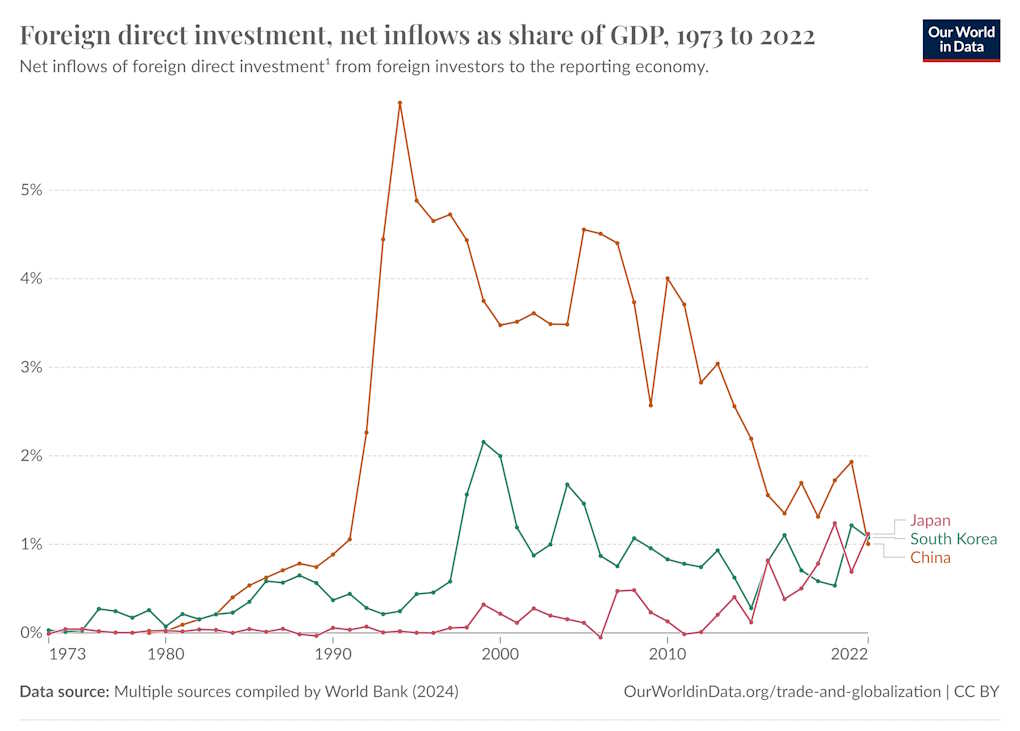
And encouragingly, greenfield FDI seems to be powering this rise. The number of inbound M&A deals has held steady, while greenfield projects have soared:
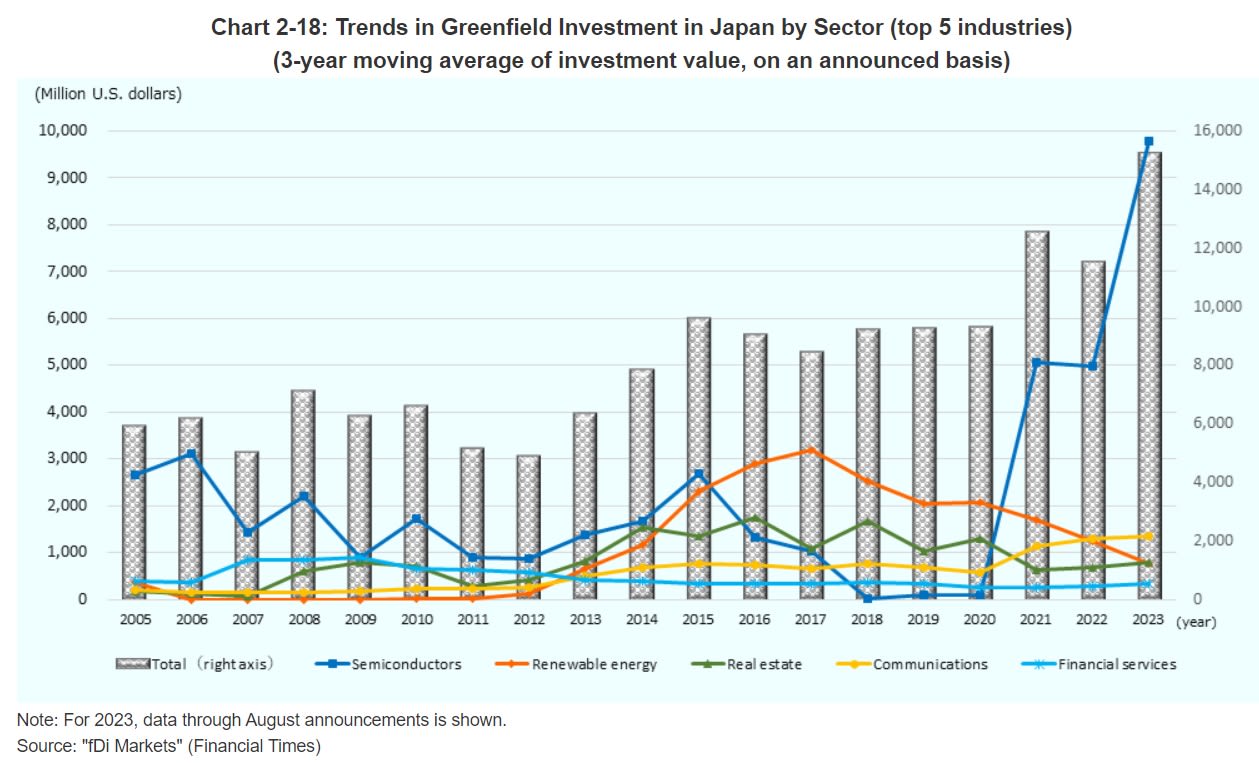
And since the semiconductor industry is powering this rise, it’s likely that a significant amount of this will result in exports.
But although this is good progress, Japan could do a lot more on the FDI front. First of all, 1.1% of GDP per year is a big improvement, but it’s not really big enough to be transformational — Poland gets over 5%, France gets 3.8%, and the U.S. gets 1.5%.
Second, most of Japan’s greenfield FDI is in one single industry — semiconductors. If Japan could attract similar levels of investment in other sectors, it would be insured against a sudden downturn in the chip industry, and it would have the chance to build up its technological muscle along a wider front. There are plenty of other high-value industries where Japan could be a high-tech, low-cost production platform — aerospace, biopharma, batteries, and electronics being four obvious examples.
In other words, Kumamoto, Sakana AI, and the other examples above are an important proof of concept for a golden age of Japanese FDI, but they should be only the beginning.
Traditionally, the reason a few foreigners wanted to invest in Japan — either through greenfield investments or M&A — was to tap the large and lucrative Japanese market. That motivation still remains to some extent, but it’s growing weaker every day. But there are a number of reasons Japan is increasingly attractive as an export platform. Understanding these reasons is absolutely crucial for Japanese government officials and businesspeople who want to attract more FDI — if you’re selling something, you must understand why your customers want to buy it.
The most obvious selling point is the weak yen. A cheap Japanese currency makes anything produced in Japan more competitive in world markets. On top of that, decades of stagnant real wages have a silver lining — they’ve made Japan’s skilled workforce look relatively cheap. A third strong point is Japan’s deep network of high-quality suppliers.
There’s also the national security angle. As China’s foreign policy has become more aggressive, the U.S. and other developed nations have begun to try to move them out of China. The U.S. government calls this “friendshoring”, while companies call it “de-risking”, but the principle is the same — no one wants to be caught dependent on Chinese manufacturers for critical high-tech products if a war breaks out. Japan is an obvious alternative production base — it’s smaller and more expensive than China, but infinitely more secure. And unlike China, Japan will not use espionage to steal foreign companies’ intellectual property.
Even Germany, which has traditionally been more willing than other Western countries to invest in China, is beginning to get nervous; a significant number of German companies are looking to switch to Japan. And the U.S. Department of Defense is planning to develop advanced weapons in Japan, as well as manufacturing more traditional munitions there.
Yet another advantage — which Japanese people may not fully appreciate, since they’ve never had to deal with the alternative — is Japan’s efficient government. In many Western countries, environmental review laws and other poorly crafted regulations have turned land use into a nightmare — projects that pass all relevant environmental and safety regulations still have to endure years of lawsuits and court-enforced paperwork, making it hellishly expensive and time-consuming to build factories. The U.S., the UK, and other anglophone countries, which rely on the courts to adjudicate environmental regulation, have become especially hostile to development.
Japan’s more sensible and efficient system, which relies more on bureaucrats than on the court system, preserves some role for community input, but allows construction projects to be approved in a timely manner. Japan’s willingness to build, meanwhile, has left it with plenty of high-quality infrastructure — and the ability to create more quickly to suit the needs of foreign investors if necessary.
But there’s one more huge reason that foreigners want to invest in Japan, which could ultimately be more important than all the rest combined. And it’s a factor that, in my experience, very few Japanese people — including the government officials tasked with promoting FDI — yet appreciate.
The key is that people around the world really love Japan, and want to live there.
(In Part III, I’ll explain why so many people in the world want to live and work in Japan — and how Japan can leverage this soft power to supercharge its FDI sector.)
2025-12-15 18:48:22
Today at a Christmas party I had an interesting and productive discussion about AI safety. I almost can’t believe I just typed those words — having an interesting and productive discussion about AI safety is something I never expected to do. It’s not just that I don’t work in AI myself — it’s that the big question of “What happens if we invent a superintelligent godlike AI?” seems, at first blush, to be utterly unknowable. It’s like if ants sat around five million years ago asking what humans — who didn’t even exist at that point — might do to their anthills in 2025.
Essentially every conversation I’ve heard on this topic involves people who think about AI safety all day wringing their hands and saying some variant of “OMG, but superintelligent AI will be so SMART, what if it KILLS US ALL?”. It’s not that I think those people are silly; it’s just that I don’t feel like I have a lot to add to that discussion. Yes, it’s conceivable that a super-smart AI might kill us all. I’ve seen the Terminator movies. I don’t know any laws of the Universe that prove this won’t happen.
One response you can have to this is to conclude that because superintelligent AI might kill us all, that we should make very, very sure that no one ever invents it. This is the thesis of If Anyone Builds It, Everyone Dies, by Eliezer Yudkowsky and Nate Soares:
This sort of reminds me of Gregory Benford’s famous admonition to “Never do anything for the first time.” You can make arguments for unforeseen catastrophic consequences for lots of different technologies. Nuclear weapons might kill us all of course, but so might synthetic biology or genetic engineering. Social media or other media technologies might collapse our societies. Video games might entrance us into virtual lives so that we never reproduce. In fact, it’s quite possible that universal literacy and reduced child mortality have already condemned humanity to dwindle comfortably into nothingness, with no artificial superintelligence required.
Personally, I do think that being so afraid of existential risk that you never invent new technologies is probably a suboptimal way for an intelligent species like ours to spend our time in this Universe. It’s certainly a boring way for us to spend our time; imagine if we had been so afraid that agriculture would kill us that we remained hunter-gatherers forever? My instinct says we should see how far technology can take us, instead of choosing to stagnate and remain mere animals.
But yes, OK, a superintelligent techno-god might kill us all. We can’t really know what it would want to do, or what it might be capable of doing. So if you really really want to be absolutely sure that no superintelligent techno-god will ever kill us all, then your best bet is probably to just arrest and imprison anyone who tries to make anything even remotely resembling a superintelligent techno-god. This is the approach of the Turing Cops in Neuromancer, the most famous cyberpunk novel.
And yet today at the Christmas party, against my better judgment, some people who think about AI safety for a living roped me into a serious discussion about their field of research. And to my utter astonishment, they actually thought I had some novel and interesting things to say.
If I can impress AI safety researchers with my thoughts on AI safety, I might as well write them up in a blog post. First, I’ll explain why I’m not very afraid that superintelligent AI will destroy humanity, and suggest some things I think we could do to minimize the risk that it will. And then I’ll explain what actually scares me about AI.
2025-12-14 18:07:36
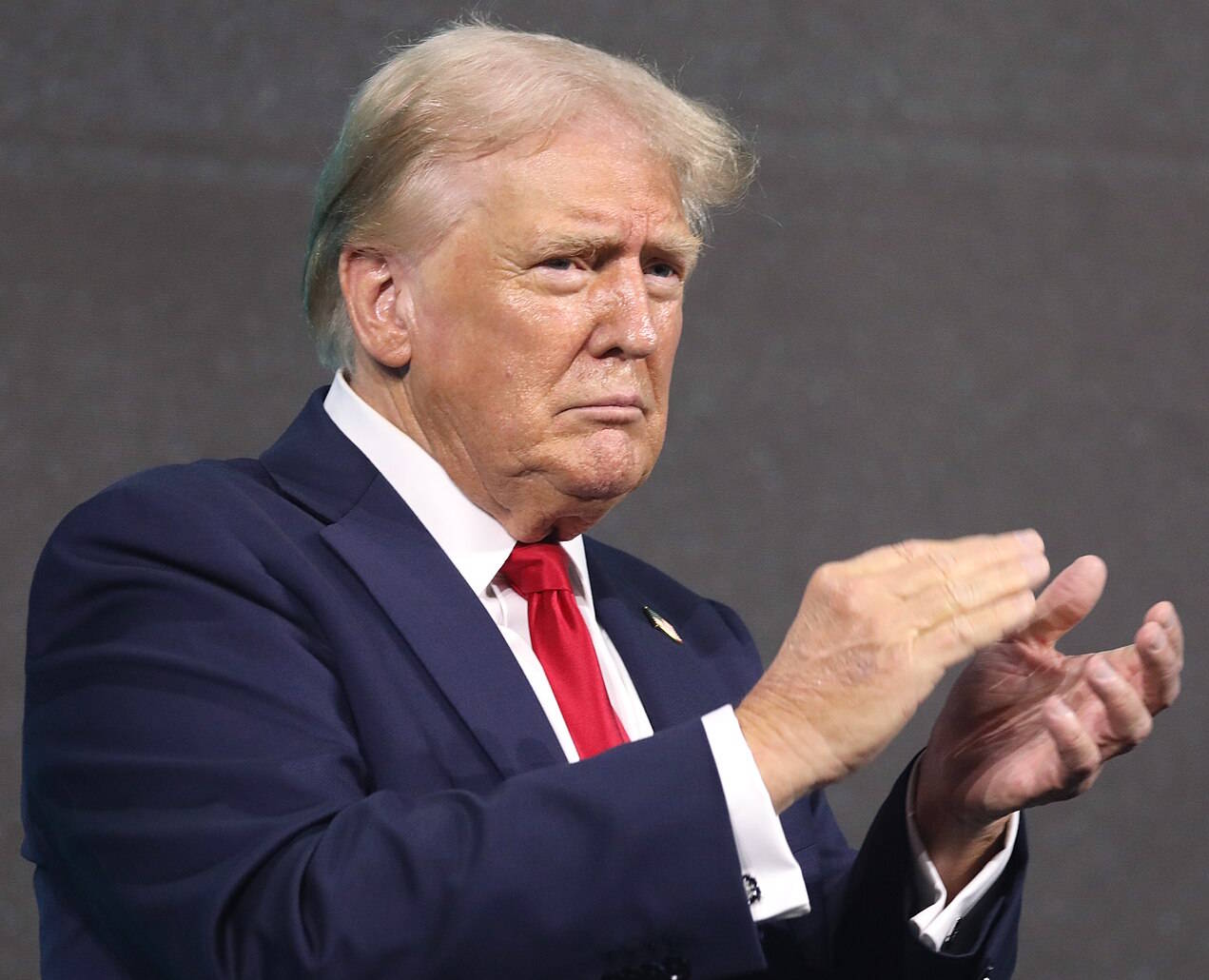
A week ago, my friend Yaroslav requested that I write more about economics and less about politics. So I deeply and humbly apologize to Yaroslav for writing another politics post.
In the past week or so, some people have claimed that the wheels are coming off the Trump presidency. For example, here’s Max Burns, writing in The Hill:
It doesn’t take a political genius to recognize that things are in free fall over at the White House…Defense Secretary Pete Hegseth is facing mounting Republican criticism over a potentially illegal order to kill the survivors of a Caribbean boat strike. Attorney General Pam Bondi’s Department of Justice is in disarray after three failed efforts to prosecute former FBI Director James Comey and New York Attorney General Letitia James…Trump’s approval rating cratered to a new low of just 36 percent in late November following months of open-air dysfunction and his repeated failure to address fundamental problems like rising consumer prices.
It’s true that Trump has had a string of setbacks recently. Indiana rejected Trump’s proposed redistricting plan, which would have used gerrymandering to give the GOP 2 more seats in Congress. The GOP-dominated Indiana state legislature openly defied Trump’s threats to cut off the state’s infrastructure funding unless they accepted the gerrymandering plan. It was a pretty remarkable act of defiance from state-level Republicans, and could indicate that Trump’s power to bully his own party into line is eroding.
Meanwhile, Democrats have been performing strongly in off-year elections:
Democrats were declared winners of the Miami mayor’s race for the first time in nearly 30 years, winning the race easily by 18 points. And…the party also flipped a Georgia state House district that Trump had carried by double digits last year…The results in Miami and Georgia were merely the latest in a series of ominous signs for the GOP’s electoral picture…Democrats also flipped the mayor’s race in suburban Roswell…Democrats…continue to over-perform in special elections by more than they ever have in the Trump era…when the districts have been somewhat competitive, the results have been strong for Democrats. This year they’ve flipped four state legislative seats that had favored Trump by double digits a year ago…Democrats have now flipped more of these seats in special elections than in any year since 2020, when they won back the presidency.
This presages a potential blue wave in the 2026 midterm elections, which is undoubtedly why Trump is so desperate to push through state-level gerrymandering plans.
These concerns were bolstered by a recent AP-NORC poll that had some very poor numbers for Trump, including on the economy and on immigration — the two main issues that Trump won on in 2024:

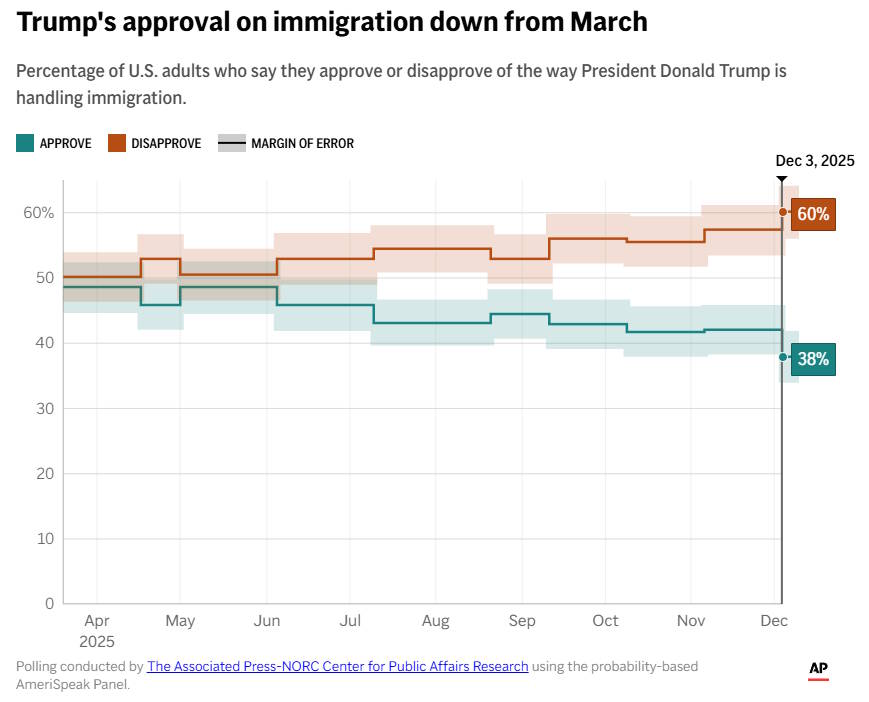
These developments do seem to reinforce the notion that Trump’s post-election honeymoon is over. But I wouldn’t be too quick to label him a lame duck, or to conclude that his power over the GOP is breaking.
First of all, the AP poll is just one poll. Overall, Trump’s approval rating has drifted downward, and he had a bad November, possibly because of the government shutdown. But since the shutdown ended, his approval has rebounded somewhat, and is still above 40% in the poll averages:
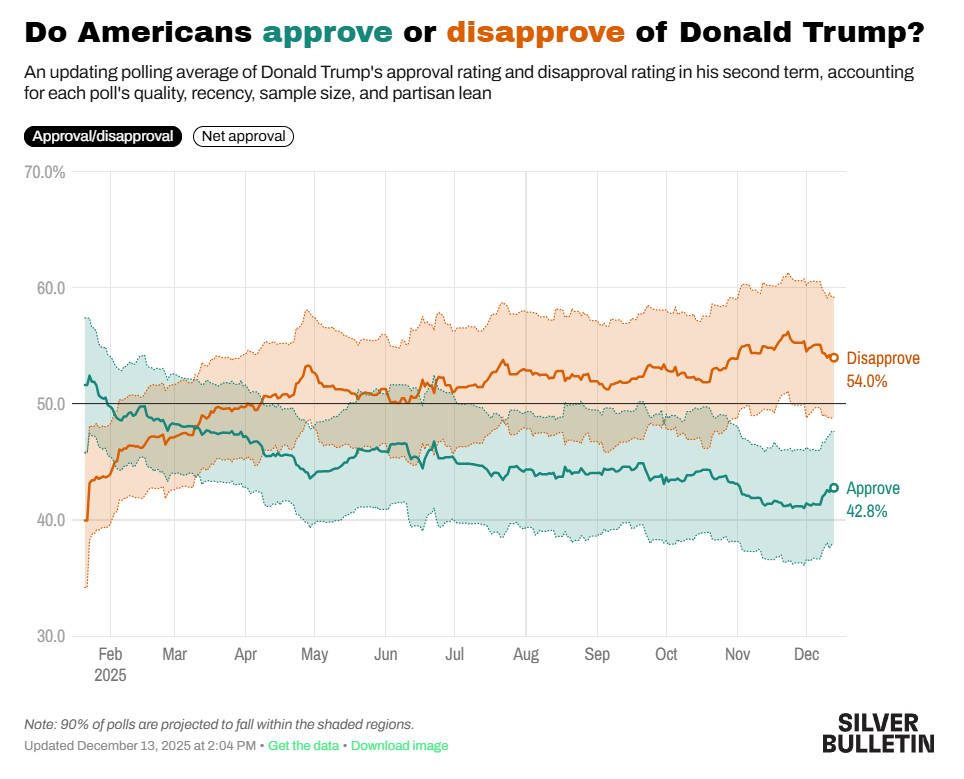
And while it’s true that Democrats will probably do well in the midterms — as the opposition party often does — a Democratic victory in Congress would not make Trump a lame duck. Democrats will not get a two-thirds supermajority, so they will be unable to override Trump’s vetoes. This means their ability to curtail Trump’s power — for example, by revoking his tariff authority — will be limited. And Trump has mostly governed by executive order in any case; Congress can pass laws that supersede the EOs, but again, not without a supermajority.
As for immigration, it’s not clear how much Trump’s deteriorating approval rating on that issue will hurt him. Those lower numbers are probably a response to the steady drumbeat of stories and videos of ICE apprehending and detaining U.S. citizens, demanding that citizens carry “immigration papers”, and generally treating people badly. But there has been no wave of popular unrest in response to those abuses, as there was to videos of police shootings in the 2010s. Overall, Americans appear to still be exhausted from a decade of street conflict.
And Trump still gets decently high marks on border security, as distinct from immigration overall:
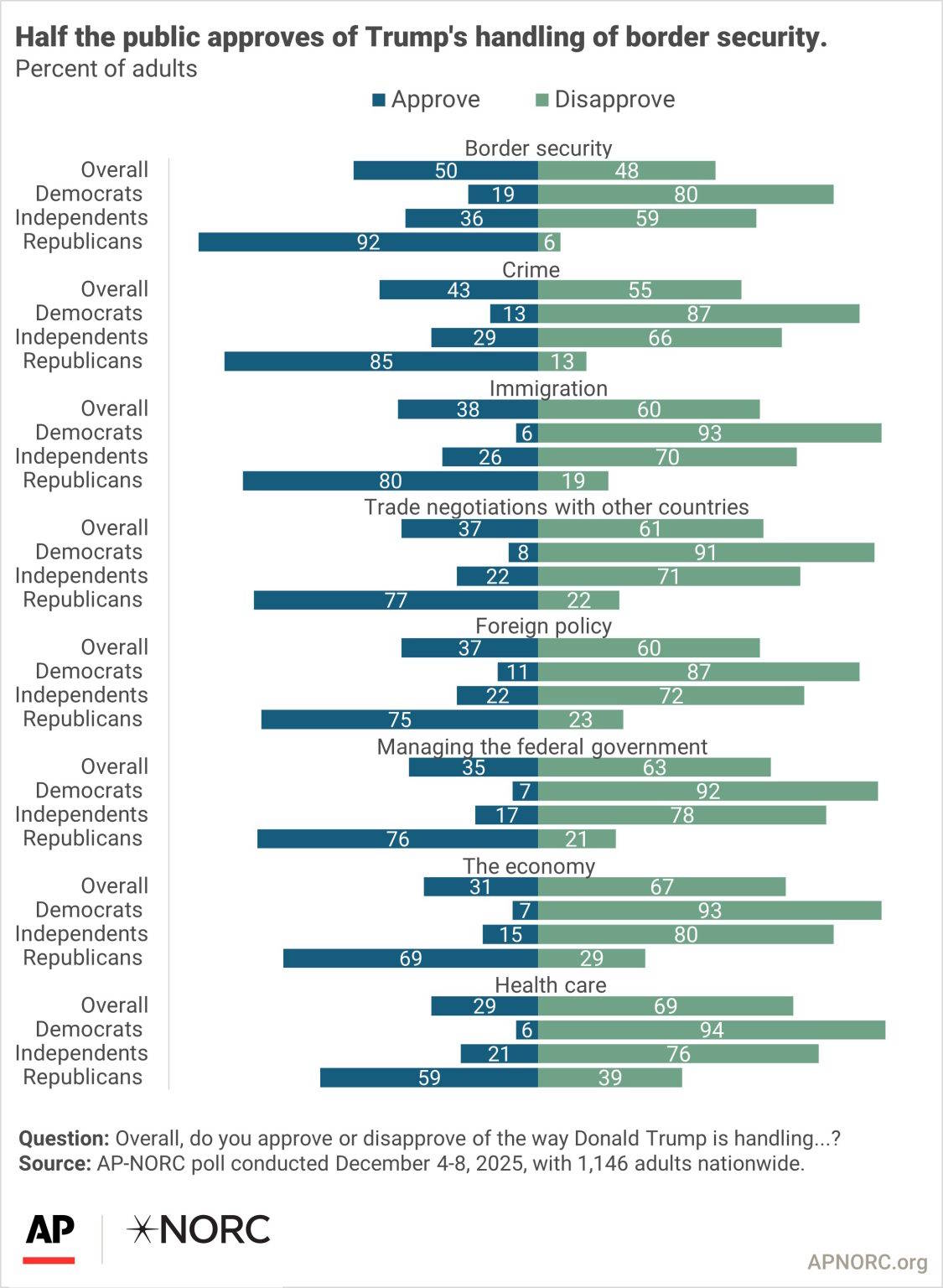
It’s not clear whether voters care about “immigration” or “border security” more; it’s possible that many voters view Trump’s ICE raids and illegal renditions with distaste, but are willing to forgive those excesses because Trump delivered on his core promise of securing the border:
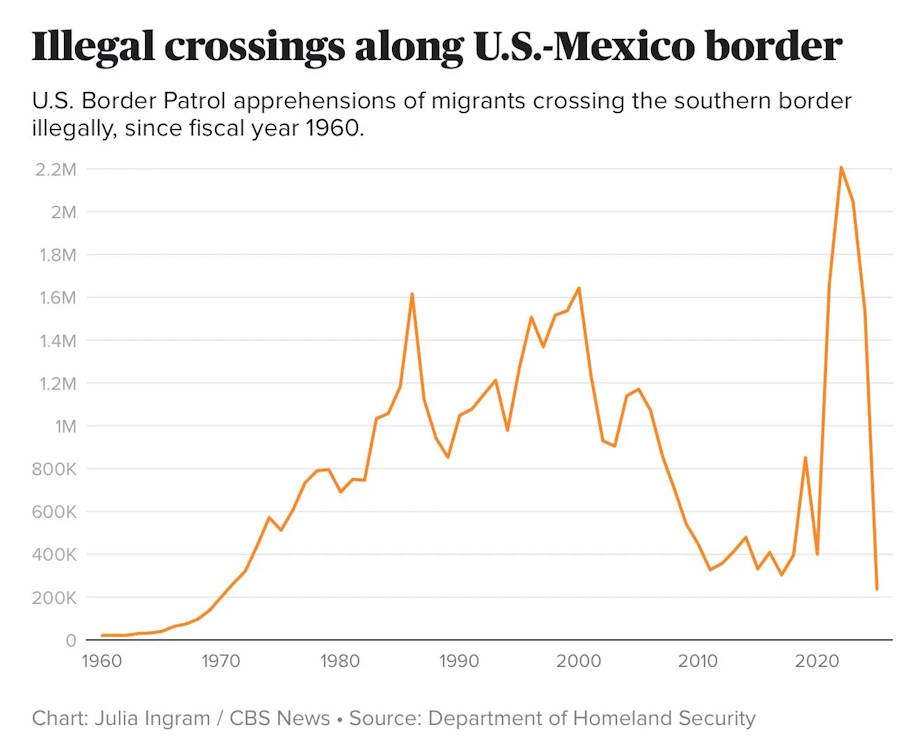
It’s possible that the racial profiling inherent in Trump’s ICE raids will drive away the Latino voters that began to join the Republican coalition in 2020 and 2024. In fact, Trump’s approval is slipping with Latinos. But for now, the immigration issue doesn’t seem to be a big liability for Trump.
And many of Trump’s other outrages, missteps, and bad policies simply don’t seem to be breaking through to the public consciousness. Avid news-readers might be aghast at Trump’s attempts to bully Ukraine into accepting an unfavorable peace deal, or at Pete Hegseth’s probably-illegal orders to massacre people on boats in the Caribbean. They might be disturbed by Trump’s plans to sell advanced Nvidia chips to China, or by rumors of an invasion of Venezuela. They might be outraged at any of the administration’s numerous corruption scandals. But a lot fewer Americans are reading the news:
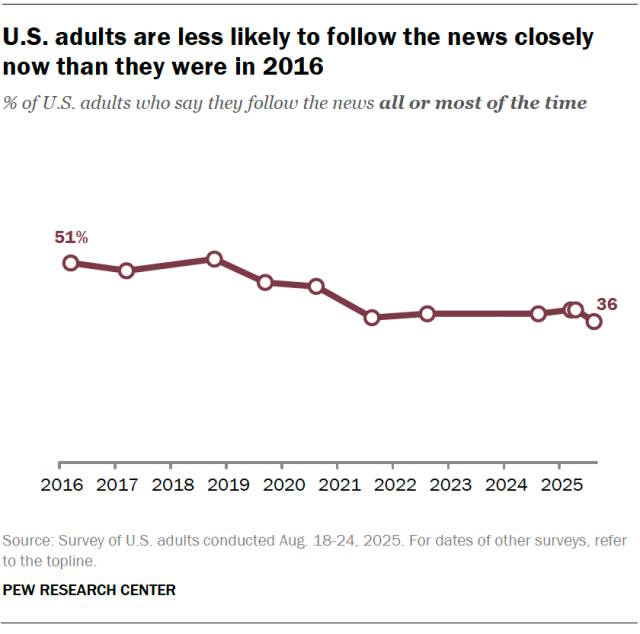
It seems to me that people can get mad about A) outrages they read about in the news, and/or B) bad stuff that happens to them in real life. With Americans tuning out the news after a turbulent decade, there is simply less scope for (A). That leaves (B). And most of the bad things Trump is doing have little or no immediate ramifications for the daily lives of average Americans.
I said “most”, but not “none”. One possible exception is the measles epidemic, which is now affecting thousands of people in South Carolina and causing hundreds more to be quarantined. This is a purely manmade epidemic; measles can be eliminated by widespread vaccination, and in fact was declared eliminated in the U.S. for many years. Now, because some Americans are choosing to forego the vaccine, the country is on track to lose its measles elimination status.
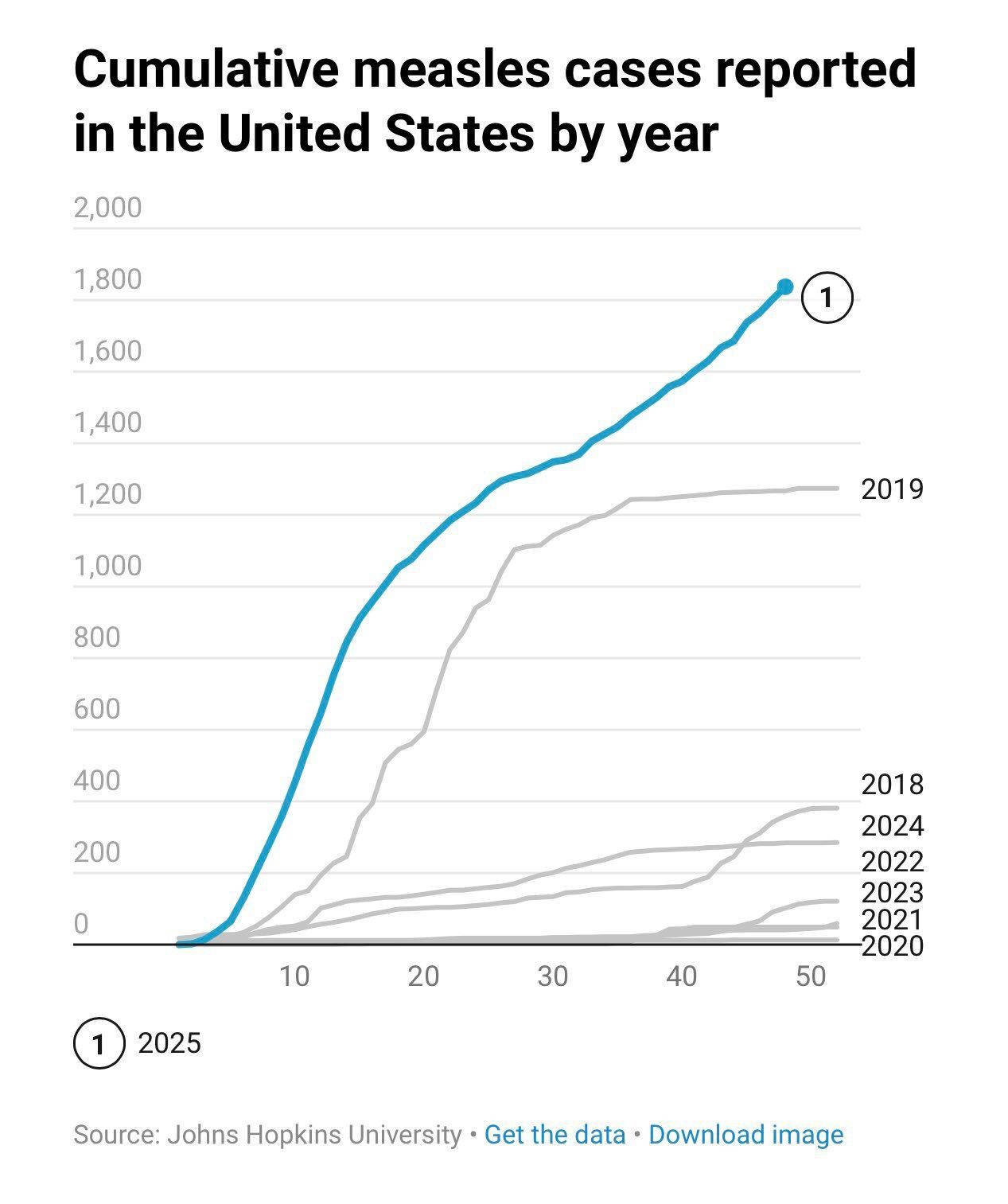
RFK Jr., Trump’s Secretary of Health and Human Services, has spread falsehoods about the measles vaccine, and even Fox News is blaming him for the outbreak. So if the disease keeps spreading, this is one thing that could disrupt normal Americans’ daily lives and cause them to sour further on Trump.
But by far the biggest thing that affects Americans’ daily lives — and where they seem to be souring on Trump’s rule — is the economy.
Americans are very, very unhappy with the state of their economy right now. Consumer sentiment is even worse now than at the lowest point in the Biden administration:
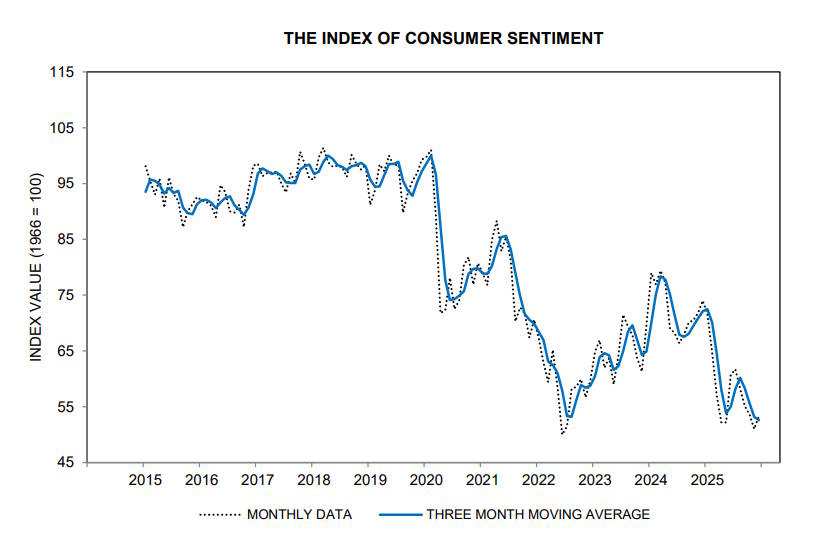
Why are Americans upset about their economy right now? Because they feel like life is getting less affordable. Polls pretty consistently show that the cost of living tops all other concerns:
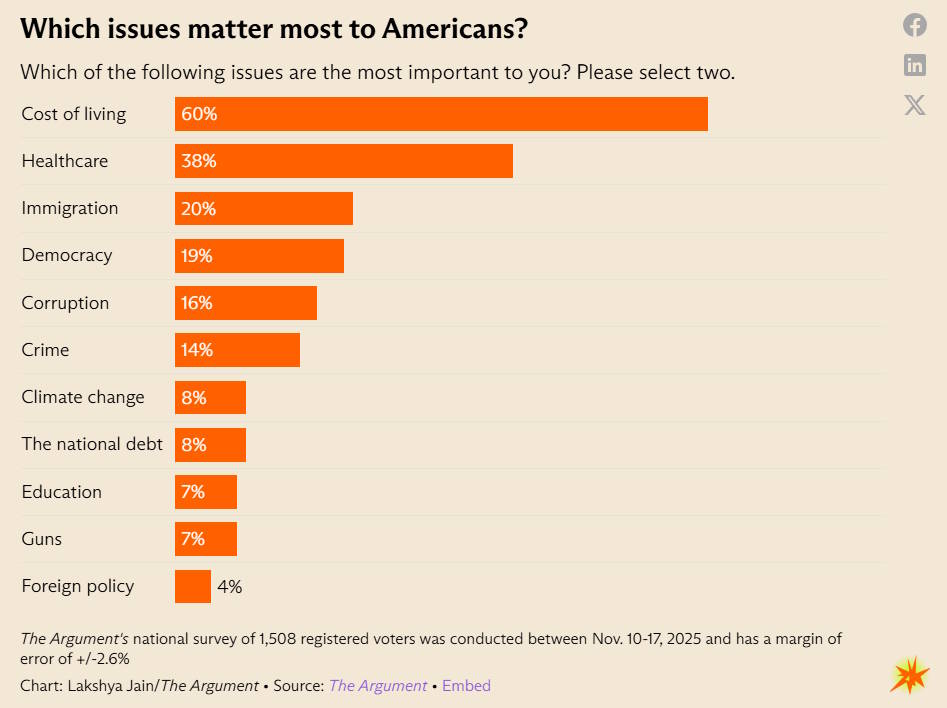
And Americans increasingly seem to blame Trump for this:
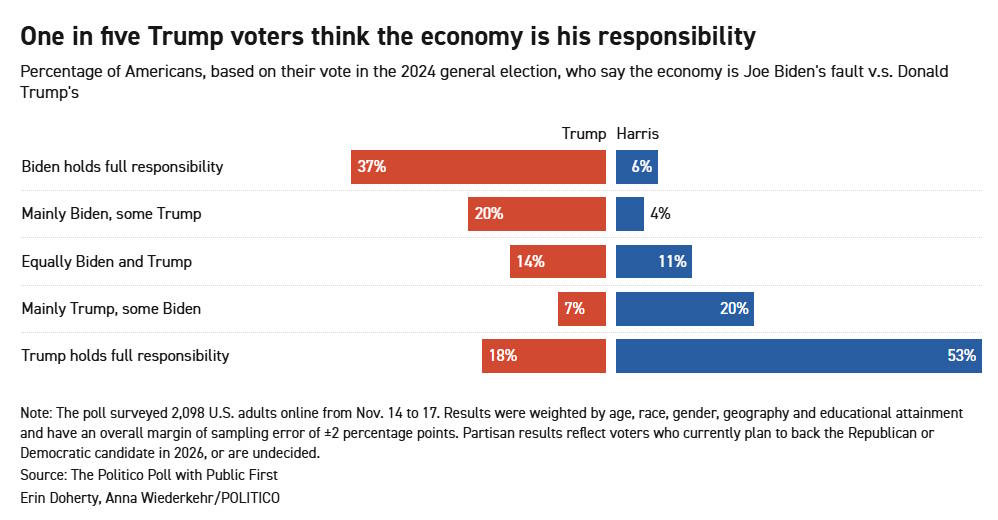
Is the affordability crisis real? Well, it depends on your perspective. Real wages for production and nonsupervisory workers — i.e. wages adjusted for the cost of living — are a good measure of purchasing power. And these have been rising steadily since 2022, meaning that life in America has been getting more affordable — at least, on average.
And although inflation is a tiny bit above target and may be rising again, it’s still far lower than in 2021-22, and pretty low by historical standards:
Why are Americans so apocalyptically negative about affordability in the Trump economy, when the objective indicators seem fairly benign? There are lots of possibilities here. People might be mad about high mortgage rates that make it hard to buy a new home. They might be finally venting their rage over decades of rising costs for big-ticket service items like health care, college, and child care (even though many of those costs seem to have plateaued or even decreased in the last few years). They might simply be using inflation as a politically neutral-sounding way to express their disapproval of Trump on sociocultural issues.
One possibility is that Americans are mad that Trump just doesn’t seem to care about affordability. His tariffs are probably contributing a relatively modest but real amount to inflation:
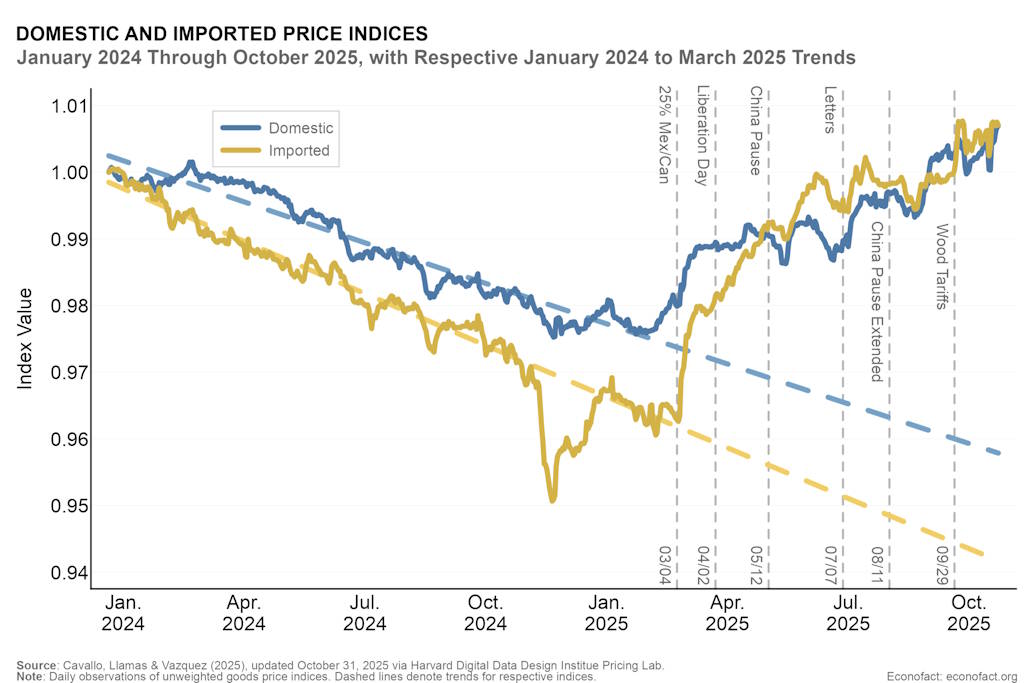
And when confronted about rising prices from tariffs, Trump has responded by sneeringly telling Americans to be satisfied with less:
“Be satisfied with fewer toys for your kids” is not the kind of message Americans like to hear, especially from a guy who lives a lavish, super-rich lifestyle. Trump has also called the affordability crisis “a hoax.”
CNN has poll results showing that it may be Trump’s perceived inactivity and lack of sympathy on affordability that is angering some voters:
[I]mportantly, a large reason for that negativity [about the economy] appears to be not just the state of affairs, but Trump’s perceived neglect…Recent polling from CBS News and YouGov shows 75% of Americans and 57% of Republicans say the administration hasn’t focused enough on lowering prices. Again, that’s a clear majority … of Republicans.
And Trump’s macroeconomic policy threatens to make the situation even worse. He consistently calls for the Fed to cut interest rates more. Rate cuts would, of course, fuel inflation, especially if they convinced American business that Trump’s Federal Reserve no longer prioritizes price stability.
Why does Trump want rate cuts? Well, lower rates push up the value of stocks, bonds, and other financial assets, which Trump and his family own a lot of. This motivation might be why Trump’s Treasury Department is tweeting out charts touting bond price increases in 2025:
Of course, bond prices go up when interest rates go down. And interest rates typically go down when the economy is in distress. Just look at the chart and realize that the only other blue bar besides 2025 is 2020, when the pandemic was raging.
It’s possible that Trump’s macroeconomic team is just confused, and doesn’t know how any of this works. But it’s also possible that they value interest rate cuts as an inherently positive, good thing.
It’s also possible that Trump still views unemployment, rather than inflation, as the main threat to the U.S. economy. The labor market is still fairly strong, but deteriorating mildly, with rising layoffs. And right now the AI boom is propping up the macroeconomy; if that boom goes bust, the resulting financial and economic crisis could cause unemployment to soar. Trump may be trying to get ahead of that scenario. Or he may simply have an instinct that tells him that price hikes are less important than jobs.
Either way, Trump’s nonchalant attitude toward inflation could end up being his undoing. So far we haven’t seen any event that hurts lots of Americans and causes Trump to lose popular credibility, as Hurricane Katrina did to George W. Bush in 2005. A rise in inflation could be that event.
So while Trump’s presidency isn’t headed for the ash-heap of history just yet, it is showing major signs of strain. If Trump keeps abusing and hollowing out the economy, eventually some sort of strain or shock will be able to tip it into crisis.
2025-12-12 11:23:48

I have some sad news to report: My podcast, Econ 102, is going on indefinite hiatus. Erik Torenberg, my excellent co-host, is very busy at his new job at a16z, and we weren’t able to keep up a regular schedule of podcasting. I apologize to all the fans of Econ 102!
Time permitting, Erik and I may return with more content later. And in the meantime, I am actively thinking about some other ways to deliver you voice and video content, so stay tuned.
In the meantime, here’s this week’s roundup of interesting econ-related stuff!
I had high hopes for the idea that just giving people cash would fix a lot of society’s problems. I still think a system of unconditional cash benefits would be simpler, fairer, and easier to navigate than many of our current welfare programs, and I still think it’s worth giving poor people money in order to make them less poor. But over the past few years, a bunch of new evidence has shown that the costs of cash giveaways are higher (in terms of incentivizing people to stop working), and the social benefits are much narrower, than boosters like myself had believed. Kelsey Piper had a great writeup of this disappointing evidence a few months ago, and I wrote up some thoughts in one of my earlier roundups.
Now we have another piece of evidence showing that cash benefits solve fewer problems than we’d like it to solve. Aaltonen, Kaila, and Nix (2025) study a recent basic income experiment in Finland. In 2017, 2000 unemployed Finnish people were randomly selected to get a change in their welfare benefits. Instead of Finland’s usual unemployment benefits, the 2000 lucky people got 2 years of cash — about $658 per month at today’s exchange rates. This allowed them to A) keep receiving cash even if they started working, and B) avoid the normal job-search requirement that comes along with unemployment benefits.
The authors find that the basic income was effective in terms of raising people’s incomes. This isn’t surprising — if you don’t stop giving unemployed people cash when they get a job, they’re going to get more money overall.
Unfortunately, though, there wasn’t much impact on labor income relative to the control group. We’d hope that if we gave people money unconditionally instead of yanking it away the moment they got a job, it would incentivize them to go find work. But in this experiment, people who no longer faced that benefit cutoff were no more likely to go make money in the market:
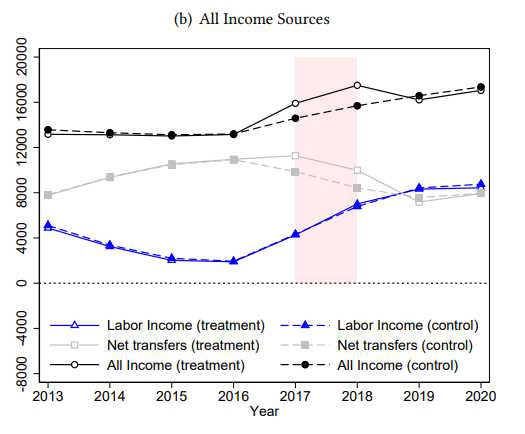
That’s disappointing. But what’s also disappointing is the main result of the paper: People who received the basic income were no less likely to commit crimes. Aaltonen et al. write:
[W]e estimate the impact of being randomized to receive a basic income on crime perpetration. We find no effect on whether treated individuals perpetrate crimes. In the two years following the start of the experiment, individuals in the treatment group were statistically insignificantly 0.5 percentage points more likely to be suspected of a crime…representing a 2 percent increase relative to the control group mean of 20 percent…
We also find that the introduction of basic income had a statistically insignificant impact on the probability of being charged [with serious crimes] in district court…Over the two-year follow-up period, the point estimate suggests that the basic income experiment increased the probability of being charged by an insignificant 0.2 percentage points…corresponding to a 4 percent increase relative to the control group…
The results [also] show no evidence that treated individuals are more likely to engage in disorderly conduct, suggesting that the basic income intervention also does not increase lower-level criminal activity…
[W]e [also] find no evidence that introducing a basic income altered victimization risk…We also find no effects when we look separately by crime type.
In other words, giving people basic income instead of traditional welfare doesn’t seem to make them less criminal, and doesn’t seem to make them safer from crime. (If anything, it made people slightly more criminal, though the result wasn’t statistically significant, so “not noticeably different from zero” is the safest takeaway here.)
In other words, basic income has taken yet another “L” here. We’d like to tell ourselves that poverty is the root of crime, but in the short term, that’s not the case — giving people more money doesn’t make them less criminal, at least in Finland. The root causes of crime are either longer-term economic factors, or deeper sociological factors.
Cash benefits still give out cash, which makes people less poor. But they don’t have a lot of the side benefits many of us had hoped for. A lot of what happens in society can’t easily be reduced to how much money people make.
A couple of years ago, I wrote about Mississippi apparently achieving a breakthrough in teaching kids to read. From what I could tell, the improvement in fourth-grade reading scores was attributable to two things: improved teaching methods for reading, and a policy of holding kids back and making them repeat grades if they couldn’t read. I wrote:
I think there are basically two lessons we can learn here. First, older education techniques are sometimes better than newer ones, and deserve to be brought back (here is another example). Second, the progressive idea of giving struggling students more resources and the conservative idea of holding students back until they’re proficient at testable skills end up working very well together.
A few days ago, Andrew Gelman — generally one of my favorite debunkers of bad statistics — wrote a blog post about this so-called Mississippi Miracle, in which he chided me for not thinking about the selection effect of holding the worst-performing kids back:
[I]f you don’t let them pass to a higher grade, you’re gonna see higher average scores among the students who do take the test. This is something that an economics journalist should realize!
Well, yeah. I admit that I didn’t realize that holding some kids back could introduce a selection effect! I simply assumed that those held-back kids would take the test eventually, when they reached fourth grade, since A) every fourth-grader has to take the NAEP, and B) America doesn’t allow kids to drop out of school before high school.
So yes, I just assumed that the held-back kids were still in the sample of test-takers, and that holding more kids back wouldn’t distort the test results in Mississippi.
In fact, I still think I made the right assumption. Where does Gelman get the idea that some of the kids are being dropped from the sample? He gets it from a recent article by Wainer, Grabovsky, and Robinson that makes the same claim:
But it was the second component of the Mississippi Miracle, a new retention policy…that is likely to be the key to their success. Third-graders who fail to meet reading standards are forced to repeat the third grade. Prior to 2013, a higher percentage of third-graders moved on to the fourth grade and took the NAEP fourth-grade reading test. After 2013, only those students who did well enough in reading moved on to the fourth grade and took the test…It is a fact of arithmetic that the mean score of any data set always increases if you delete some of the lowest scores.
But why do Wainer et al. think the students who are held back end up being dropped from the sample of test-takers, instead of merely delayed to another year’s sample? It’s not clear. Kelsey Piper thinks Wainer et al. just haven’t thought very carefully about how education works in America:
[A] major plank of Mississippi’s reading reforms is a test of basic reading fluency administered at the end of third grade. Kids who don’t pass it are held back a year. For at least five years, people have argued that maybe this, rather than any actual teaching skill present in Mississippi, is what’s driving the state’s improvements.
A provocative new article from Howard Wainer, Irina Grabovsky, and Daniel H. Robinson in Significance argued that, in fact, nearly all of Mississippi’s results are driven by the third-grade retention policy, not by the phonics instruction, curriculum changes, or the teacher training that accompanied them. It has gone viral, with lots of glee in certain quarters, where it was sometimes taken as proof that there’s nothing other states need to learn from Mississippi after all…This is an important debate, but I’ve been dismayed to see their article treated as a significant contribution to it…
Strangely, [Wainer et al.] treated holding back 5% of students as identical to truncating the lowest 5% of test scores. But those are two different things, which makes their conclusion, that truncating the scores would be sufficient to explain Mississippi’s gains and therefore that other reforms played no role, invalid…
A student that repeats the third grade does not conveniently vanish off the face of the earth. They just … take third grade again, and then they move on to fourth grade. The state still tests them; they just do so a year later…If a student is held back a year, they still take the test again when they do reach fourth grade…Under Mississippi’s retention law, a student can usually only be retained for a maximum of two years.
They will still go on to fourth grade and therefore still take the test. This makes Wainer et al.’s entire analysis of how the mean shifts in a truncated dataset void.
What’s more, Piper digs into the Mississippi test score data — something that Gelman admits he didn’t do — and finds some very clear signs that the test score gains aren’t from holding kids back:
If all of Mississippi’s gains were from the bottom 10% of students being held back and then getting to take the test a year later…We would not expect the strongest students to be affected at all — none of them are held back, and almost no child is going to go from bottom 10th to top 10th in a single year…The NAEP publishes test scores broken down by decile. And what we see is that Mississippi has seen gains in every decile. [emphasis mine]
Now of course, switching to a policy of holding more kids back could temporarily juice scores for a couple of years, while the first cohort of weaker kids was being held back. But Piper notes that a lot of Mississippi’s test score gains came from well before 2015, when the policy switched. And she also notes that the gains haven’t been reversed since 2017, meaning that any illusory gains from that first held-back cohort are out of the sample by now.
Anyway, Andrew Gelman did apparently realize that the kids who are held back aren’t just dropped from the sample. At the end of his post, he writes:
I still wonder what happens with those kids who are held back and are then tested a year later. I guess they improve on average a lot on their own, no matter what is done, during that year.
But the kids who are held back are not “on their own”. They are still in school. And to claim that they improve “no matter what is done” doesn’t make sense, since all of them are still in school. So I’m not sure what Gelman is talking about here.
I’m not sure why Gelman, who is normally among the most perceptive thinkers when it comes to data issues like this, simply takes the conclusions of Wainer et al. at face value instead of interrogating their extremely questionable assumptions.1 Being a researcher instead of merely a journalist, he should dig into the data himself, and investigate whether there’s actually any reason to believe that the Mississippi Miracle is fake.
In the aftermath of the death of right-wing activist Charlie Kirk, there has been a lot of consternation that his shoes would be filled by Nick Fuentes. Fuentes is the leader of a movement called the Groypers that emphasizes antisemitism, ethno-nationalism, and various other race-war stuff. Richard Hanania has done a great job tracking how Groyperism has slowly taken over among the Republican staffer class, and among young Republican circles more generally. Fuentes is at the head of that movement, with his podcast briefly hitting the #1 spot on Spotify before being taken down.
A new study by the Network Contagion Research Institute has shown that Fuentes is being boosted by some shadowy, nefarious forces. Colin Wright, himself a man of the political right, has a good post explaining the findings:
Some key excerpts from Wright’s post:
According to NCRI, Fuentes’s apparent rise was driven by coordinated manipulation of online platforms, artificial engagement meant to boost his posts, and an information ecosystem in which major media outlets can be misled into thinking a fringe figure is suddenly influential…
The report’s most shocking finding is just how wildly Fuentes’s engagement numbers differ from those of other political influencers. NCRI compared the first 30 minutes of engagement on 20 of his recent posts with those from four major online figures—Elon Musk, Hasan Piker, Steven “Destiny” Bonnell, and Ian Carroll. Incredibly, Fuentes outperformed all of them in early retweets, including Musk, whose follower count is over 200 times higher…
None of this makes sense if the engagement is organic. According to NCRI’s report, this is explained by the fact that 61 percent of Fuentes’s early retweets come from accounts that repeatedly retweeted several of his posts within the same 30-minute window. This is not what you’d expect if these were random users scrolling their feeds. Rather, these accounts appear to be waiting for Fuentes to post so they could amplify his content almost instantly…
When NCRI dug into who these accounts actually were, 92 percent were completely anonymous. No real names, no real photos, no location, no identifiable personal information…When they examined Fuentes’s most viral posts—three from before the assassination of Charlie Kirk and three after—[NCRI] found that nearly half of all retweets came from foreign accounts, heavily concentrated in India, Pakistan, Nigeria, Malaysia, and Indonesia.
It’s not clear who is boosting Nick Fuentes. Pakistan, Nigeria, and so on are simply places where you can hire a bunch of people (and bots) to do artificial engagement-boosting. It could be any one of America’s foreign adversaries (all of whom Fuentes praises on his show), or it could be rightist rich people in America trying to boost their extremist ideology.
Either way, the proper takeaway here is NOT “Hahaha Fuentes’ popularity is fake, we don’t have to worry about Groypers taking over.” Fuentes’ popularity started out fake, but it didn’t entirely stay there — he got an interview with Tucker and has been covered by all the major media outlets, and his podcast soared in popularity (even if some of those downloads might be from bots). His ideas have probably been able to influence a significant number of young conservatives.
The proper lesson here is that new media technology — especially X and other viral media platforms — has tipped the scales of political discourse toward the worst extremists in our society. Unless and until we develop new institutions capable of gatekeeping out people like Fuentes, shadowy actors will use bots and paid engagement farming to boost them far out of proportion to whatever natural appeal their ideas would have had — thus destabilizing our democratic society.
We hear a lot about worsening social trends in America — higher murder rates, more suicide, more drug overdoses, more traffic deaths, and so on. But it’s starting to look like a lot of that deterioration was just a temporary bump from the pandemic and/or the nationwide unrest in 2020. Jeremy Horpedahl recently posted a great chart showing that most of these trends have been reversing since 2022:
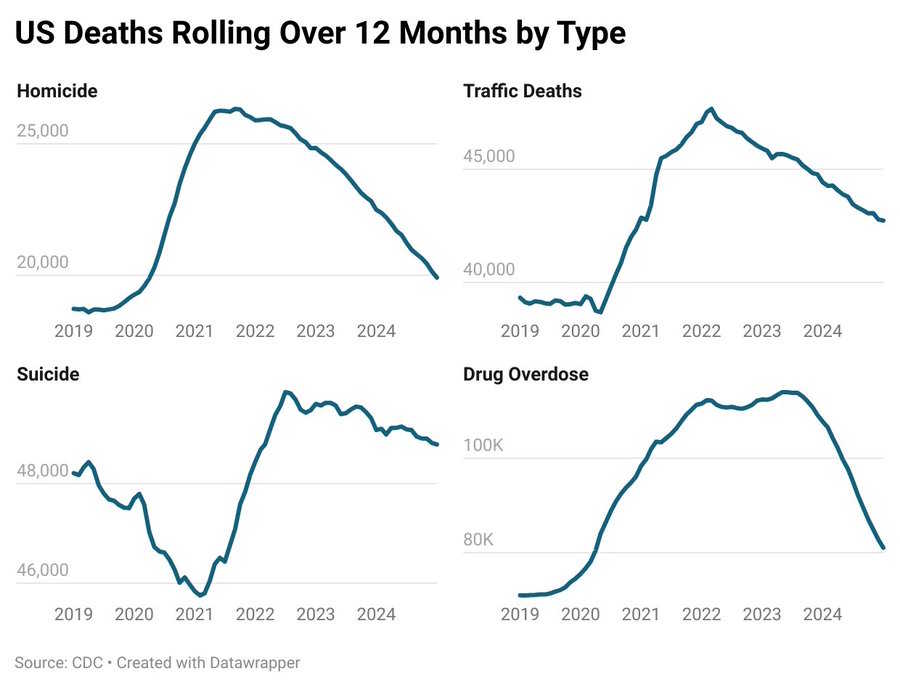
If these trends were due to specific policies — gun control, health care policy, drug enforcement, road safety policy — we wouldn’t expect them to line up so perfectly, and we probably would expect them to line up with changes in presidential administration or Congressional control. But they do line up, and the timing doesn’t seem to fit any political changes.
In other words, it seems like it’s possible for societies to just “break” and “fix themselves” in ways we don’t entirely understand. In other words, there is some sort of sociological macro-cycle out there.
Macrosociology?
If you look at a map of per capita income, Botswana stands out from the rest of Sub-Saharan Africa. It’s not a rich country, but it’s comfortably middle-income, and does even better than South Africa:
Why is Botswana doing so well? Two reasons: Diamonds, and good policy. Botswana is richly endowed with diamonds, which represent the vast majority of the country’s exports. The country has slowly taken over the international diamond trade, including the company De Beers. And unlike many African countries, Botswana has funneled the money from its mineral exports back into constructive things like education and health. This is made possible by its high level of political stability, which may in turn be a function of its ethnic homogeneity (most Botswanans belong to a group called the Tswana). All in all, Botswana provides a hopeful case that poor resource-exporting countries can escape the dreaded Resource Curse.
But this success could now be under threat. Diamonds are valuable because they’re useful (they look pretty and have many industrial applications too), and because they’re scarce. But artificial diamonds are getting better and better, and soon even the highest-quality diamonds might not be so scarce:
Africa’s trade in natural diamonds [is buckling] under growing pressure from cheaper lab-grown diamonds mass-produced mainly in China and India…Diamond exports, roughly 80% of Botswana’s foreign earnings and a third of government revenue, have tumbled…In September, Botswana’s national statistics agency reported a 43% drop in diamond output in the second quarter, the steepest fall in the country’s modern mining history. The World Bank expects the economy to shrink 3% this year, the second consecutive contraction…
The global rise of synthetic diamonds has been swift…The gems emerged in the 1950s for industrial use. By the 1970s they had reached jewelry quality. Lab-grown stones now sell for up to 80% less than natural diamonds. Once making up just 1% of global sales in 2015, they have surged to nearly 20%…Lab-grown stones now account for most new U.S. engagement rings, he said. Natural diamond prices have fallen roughly 30% since 2022.
This demonstrates a fundamental principle of economic development: In the long term, countries do not become rich from digging up rocks. Humans are ingenious creatures, and we’re always figuring out ways to use resources more efficiently, to substitute common resources for scarce ones, and to use technology to imitate nature. If your country’s prosperity is based on rocks — i.e. on exploiting nature’s bounty in a straightforward, extractive manner — then human ingenuity is working against you.
Botswana’s experience should give pause to the lefty activists who believe that global poverty is due to rich countries exploiting poor countries for their natural resources. Botswana is basically the poster child for the idea that poor post-colonial economies can succeed by taking control of their rocks and selling them at higher prices in global markets. But their success only ever brought them to middle income, and now it’s under dire threat from technological innovation.
The real lesson here is that national wealth comes from ingenuity and hard work, not from sitting on top of rocks.
Part of a pundit’s job is debunking viral charts. I wrote a two-part series on how not to be fooled by these charts. Today we have another example: the correlation between prison and mental institutions.
Have you ever seen this chart?
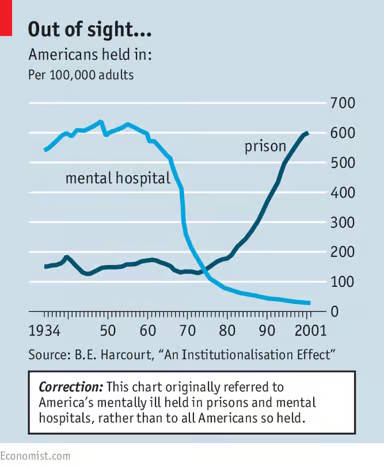
This chart comes from a 2013 article in The Economist, which got its data — and its thesis — from a 2011 paper by a law professor named Bernard Harcourt. But in an excellent recent post, Matt Yglesias dug into Harcourt’s papers and showed that the thesis just doesn’t hold up:
Yglesias points out that most of the people going to jail and prison in the 80s and 90s couldn’t have been the same people who were let out of mental hospitals, because a lot of the people in mental hospitals were white women or the elderly:
But (thanks to Xenocrypt for the tip) as Steven Rafael and Michael Stoll pointed out over a decade ago, the population in mental hospitals in 1950 was 87 percent white and 47 percent female. Twenty percent were over the age of 65 in an era when the aggregate population was much younger (only 8 percent of the public were senior citizens)…It is simply not the case that 40 percent of prison inmates are white women or 20 percent of crimes are being committed by senior citizens. We’re just not seeing anything remotely resembling a one-to-one substitution effect here.
Harcourt speculates that mental patients might be raising the crime rate by providing easy victims rather than by actually committing crimes, but Yglesias points out that this doesn’t make sense either, given what we know about victimization statistics.
Yglesias also notes that an earlier Harcourt paper made the much more modest claim that de-institutionalization caused between 4.5% and 14% of the rise in incarceration — in other words, not nearly enough to produce the viral chart.
It’s possible that some people did go from mental institutions to prison when we closed down mental institutions. But this was not the main reason for the rise in incarceration, or even a very big reason. The viral chart is just telling the wrong story.
In the eternal quest to get America to build more housing, it’s important to take politics into account — we have to know how best to avoid activating the ire of local NIMBYs who block housing projects. If you post pictures of new housing online, lots of people inevitably pop up to say the new housing is ugly. And this concern is often raised at various public meetings as well.
But how real are the aesthetic concerns here? Are people just using architecture and style as excuses to block poor people from living near them, or to preserve their quiet streets? A pair of recent papers tried to answer that question by taking surveys, and came up with somewhat conflicting results.
The first paper is by Broockman, Elmendorf, and Kalla. Here’s a thread by Broockman explaining the findings. The authors surveyed people about when they would and wouldn’t support building new housing. Basically, they found that people are fine building more tall apartment buildings in places that are already dense, but oppose it in places that aren’t dense — even if it’s not their own back yard.
Why? The survey respondents said that cities “look nicer” without tall buildings. They also opposed the construction of office buildings, which the authors interpret as meaning that people genuinely care about aesthetics instead of just keeping poor people away. (I’m not so sure; downtown areas may also carry the connotation of being places where lots of poor people hang out.)
Broockman et al. argue that opposition to new buildings can be mitigated by making the new buildings look nice. They find greater support for building nice-looking buildings — the third panel in the pic, instead of the first panel:

I’m a little suspicious of these choices of photos; the first one shows not just an ugly building, but also displays some even taller buildings immediately abutting it, and also some cars on the street that indicate density. The third photo shows trees and gaps between structures, indicating a quiet street and low density. But in any case, the authors think this means that aesthetics matter a lot. They also find that support for building more goes up when they specify that the building would be designed by a star architect.2
Anyway, the second new paper, published just one day earlier, is by Pietrzak and Mendelberg. Here’s a thread by Pietrzak explaining their findings. They also survey a bunch of people about which apartment buildings they would like to see get built.
Two of Pietrzak and Mendelberg’s findings are very similar to Broockman et al. They find that people don’t like tall buildings, but that they support them more if they’re going to be put in neighborhoods that already have tall buildings.
But when it comes to actual building design, their findings were very different from the other paper. Pietrzak and Mendelberg found that there was no preference for traditional brick styles over more modern styles. And whether a tall building has the same style as the buildings around it also has almost no effect; people basically just don’t like tall buildings.
Taken together, these results convince me that Americans believe that tall buildings should be restricted to just a few neighborhoods. That will be an important attitude to overcome, since densifying the inner-ring suburbs will be necessary in order to build significantly more housing in America. But I’m not yet convinced that making buildings look nice makes any real difference to whether Americans will allow them. Further research on that question is needed, and there are probably some natural experiments out there with building code changes along municipal boundaries that could be used to tease out this effect.
AI is the world’s most important industry, and China is the source of almost half of the top AI talent in the world:
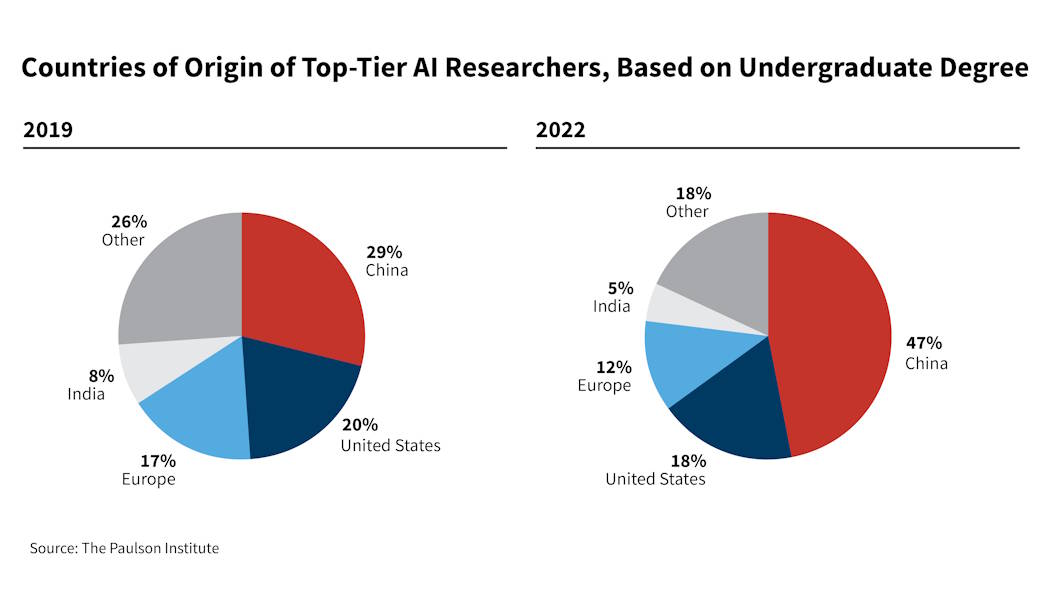
Domination of the global AI industry is going to largely come down to which country can attract more Chinese talent. Until recently, America was dominating China in this race; most of the best Chinese AI researchers wanted to come and work in the U.S. There has been a lot of (justified) fear that Trump’s policies would reverse this advantage and drive Chinese researchers back to China.
According to a new report by the Carnegie Endowment, brain drain back to China has been very modest so far. Only a small sliver of the Chinese top AI researchers working in America has gone back to their home country since 2019:

The Carnegie Endowment report does highlight a few prominent researchers who have gone back to China, like Yang Zhilin. But so far these are the exception rather than the rule. And their return isn’t even necessarily due to Trump — China is pouring money into the AI industry, and companies like DeepSeek have emerged as real competitors to American industry leaders.
The Carnegie report explains that the bigger worry for the U.S. isn’t brain-drain — it’s that Chinese talent won’t even come here in the first place:
Although the United States has managed to retain a large portion of Chinese AI researchers over the past six years, there are signs that it has lost some of its ability to attract new arrivals from China—a potentially ominous trend given China’s share of global AI talent…
By [2022], Chinese-origin researchers made up nearly half of all the authors sampled, and Chinese institutions had more than doubled their share to 28 percent [since 2019]. That was still well short of the U.S. share of 42 percent, but it demonstrated rapid catch-up by China in producing many of the year’s best AI research papers.
Everyone seems to be sleeping on just how much China dominates the production of global top AI talent. If other countries can’t improve their own talent pipelines, their AI industries will continue to be dependent on luring Chinese people out of China.
Gelman also uncritically repeats Wainer et al.’s claim that Mississippi ranked 50th in the nation for 4th-grade math. In fact, as Piper points out, Mississippi actually ranked 16th. Wainer et al. simply made a mistake.
I’m a bit suspicious of this question too, as it might imply a ritzy, upscale area where poor people would be less likely to hang out.